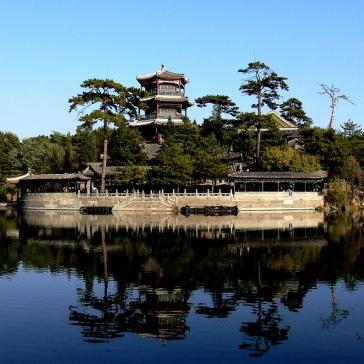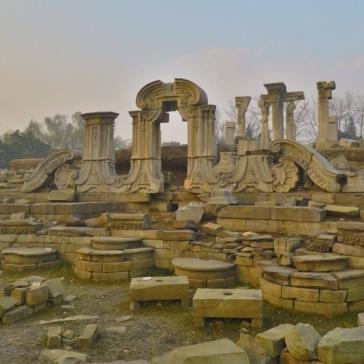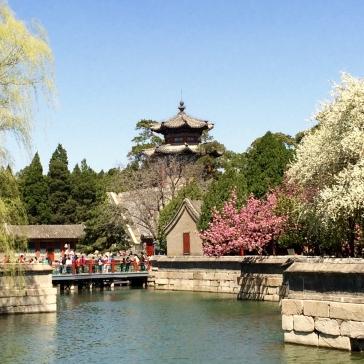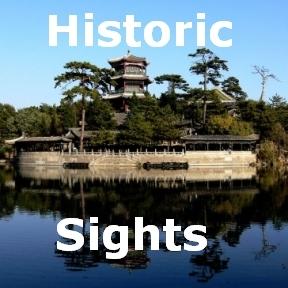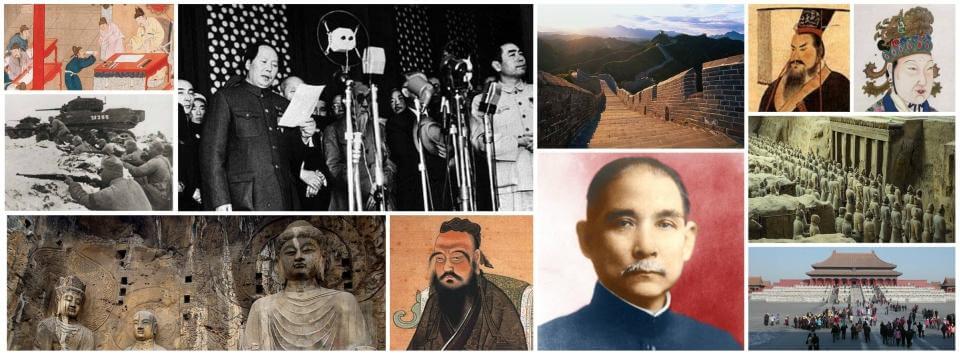
Qing Dynasty (AD 1644 - 1912)
Read the end of the previous section to learn about the decline and eventual fall of the preceding Ming dynasty.
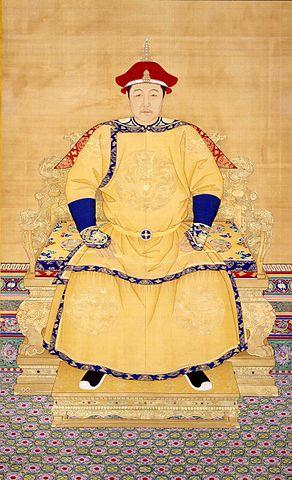 Portrait of the Shunzhi EmperorAfter the Shunzhi Emperor (AD 1638 - 1661) died in AD 1661, his then-seven-year-old son Xuanye succeeded him on the throne. Xuanye was only the third son of the Shunzhi Emperor. He was chosen for this role due to his hardiness and fitness, which he had shown by already having survived smallpox at such a young age. Xuanye went on to reign for a long time as the Kangxi Emperor (AD 1654 - 1722). During the first 5 - 6 years of his reign, he was however assisted by a council of regents since he was then still too young to rule all by himself. The council of regents was made up of members of the ruling Manchu family and it was Xuanye's uncle Oboi that effectively led and controlled it. Therefore, this early period of the Qing dynasty is now known as the Oboi regency.
Portrait of the Shunzhi EmperorAfter the Shunzhi Emperor (AD 1638 - 1661) died in AD 1661, his then-seven-year-old son Xuanye succeeded him on the throne. Xuanye was only the third son of the Shunzhi Emperor. He was chosen for this role due to his hardiness and fitness, which he had shown by already having survived smallpox at such a young age. Xuanye went on to reign for a long time as the Kangxi Emperor (AD 1654 - 1722). During the first 5 - 6 years of his reign, he was however assisted by a council of regents since he was then still too young to rule all by himself. The council of regents was made up of members of the ruling Manchu family and it was Xuanye's uncle Oboi that effectively led and controlled it. Therefore, this early period of the Qing dynasty is now known as the Oboi regency.
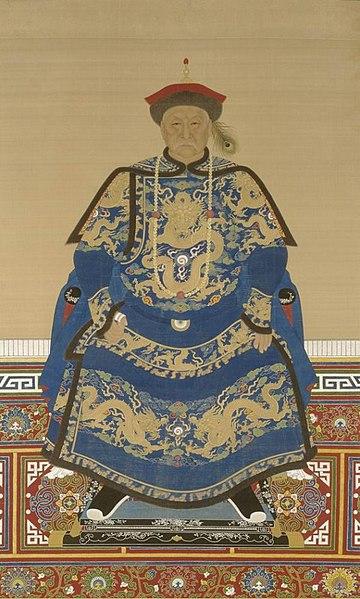 Portrait of the Regent OboiEven though he was still only a teenager in AD 1667, the Kangxi Emperor ended his uncle's reign and disbanded the regency in order to rule by himself. Taking over a largely pacified and economically prosperous country, the Kangxi Emperor's reign marked the beginning of the greatest period of the Qing dynasty (and possibly of the entire Chinese imperial history). However, soon after taking the imperial reigns into his own hands, the young Kangxi Emperor and the Qing dynasty had to face one more great challenge in the 1670s.
Portrait of the Regent OboiEven though he was still only a teenager in AD 1667, the Kangxi Emperor ended his uncle's reign and disbanded the regency in order to rule by himself. Taking over a largely pacified and economically prosperous country, the Kangxi Emperor's reign marked the beginning of the greatest period of the Qing dynasty (and possibly of the entire Chinese imperial history). However, soon after taking the imperial reigns into his own hands, the young Kangxi Emperor and the Qing dynasty had to face one more great challenge in the 1670s.
At that time, a rebellion broke out in the southwest of China which is now known as the "Revolt of the three Feudatories". It was led by the former Ming general Wu Sangui, who had enabled the Manchu's ascent to power in the first place by opening the gates for their armies at the Shanhai Pass at Shanhaiguan (as described in the previous section about the Ming dynasty). Wu Sangui and the two other former Ming generals who had joined this rebellion had been handsomely rewarded by the Manchus for their earlier cooperation. They had received huge territories of land in the southwest of China which they had henceforth ruled as their private feudal domains.
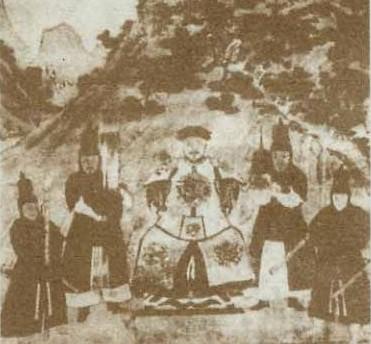 Wu Sangui (center), former Ming general and initiator of the "Revolt of the three Feudatories"The rebellion of the three former Ming generals was triggered when the Manchus, possibly to thwart succession of these territories to the former generals' sons, tried to reestablish their control over these parts of southwestern China in the 1670s. Putting down this rebellion occupied the Qing army for about eight years until the early 1680s, also due to the fact that other Chinese armies in the south and southwest of China had joined Wu Sangui's side. The Manchu-led Qing army also had to thank the surprising loyalty of the ethnically Chinese soldiers within their ranks for their ultimate success in this campaign.
Wu Sangui (center), former Ming general and initiator of the "Revolt of the three Feudatories"The rebellion of the three former Ming generals was triggered when the Manchus, possibly to thwart succession of these territories to the former generals' sons, tried to reestablish their control over these parts of southwestern China in the 1670s. Putting down this rebellion occupied the Qing army for about eight years until the early 1680s, also due to the fact that other Chinese armies in the south and southwest of China had joined Wu Sangui's side. The Manchu-led Qing army also had to thank the surprising loyalty of the ethnically Chinese soldiers within their ranks for their ultimate success in this campaign.
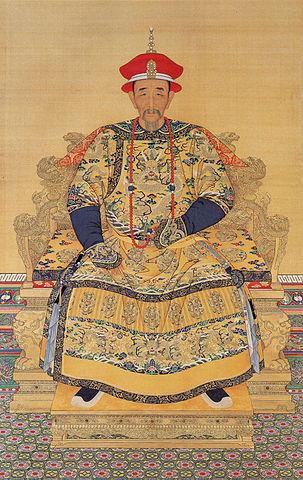 Portrait of the Kangxi EmperorThat showed that the Qing dynasty was already seen as legitimate and had established a sufficient degree of loyalty among the ethnically Chinese population by the 1670s. The Chinese might have been grateful for the return of peace to their lands and the chance to return to their normal livelihoods after many years of military conflict. The Qing rulers hadn't sought to excessively transform or punish China for its earlier resistance to their rule either. One exception to this might have been the Jiangnan region which was much more heavily taxed under Qing rule than all the other areas, possibly as punishment for its earlier exceptionally fierce resistance to Qing rule or maybe simply due to its relative prosperity.
Portrait of the Kangxi EmperorThat showed that the Qing dynasty was already seen as legitimate and had established a sufficient degree of loyalty among the ethnically Chinese population by the 1670s. The Chinese might have been grateful for the return of peace to their lands and the chance to return to their normal livelihoods after many years of military conflict. The Qing rulers hadn't sought to excessively transform or punish China for its earlier resistance to their rule either. One exception to this might have been the Jiangnan region which was much more heavily taxed under Qing rule than all the other areas, possibly as punishment for its earlier exceptionally fierce resistance to Qing rule or maybe simply due to its relative prosperity.
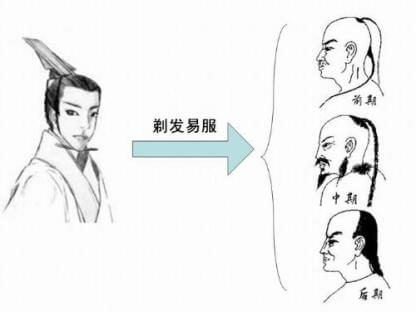 from the old hairstyles to the new mandatory Manchu queue under the Qing dynastyOne new rule that the Qing had imposed (which became deeply unpopular near the end of their dynasty) was that all Chinese men had to wear their hair in the Manchu style. The Manchu queue (a long braid at the rear of the head with the rest shaved) was quickly accepted by the Chinese. This acceptance did not exactly come voluntarily though. Instead, wearing a mandatory Manchu queue was accepted due to fear of the possible consequence of non-compliance. After all, failure to comply with this rule could be punished by execution. In later years, the Manchu queue gradually came to be seen as a symbol of "Chineseness".
from the old hairstyles to the new mandatory Manchu queue under the Qing dynastyOne new rule that the Qing had imposed (which became deeply unpopular near the end of their dynasty) was that all Chinese men had to wear their hair in the Manchu style. The Manchu queue (a long braid at the rear of the head with the rest shaved) was quickly accepted by the Chinese. This acceptance did not exactly come voluntarily though. Instead, wearing a mandatory Manchu queue was accepted due to fear of the possible consequence of non-compliance. After all, failure to comply with this rule could be punished by execution. In later years, the Manchu queue gradually came to be seen as a symbol of "Chineseness".
The reign of the Kangxi Emperor was also characterized by his efforts to incorporate neighbouring peoples into his Qing empire, be it through diplomacy or military campaigns. The eastern Mongol tribes had already become close allies of the Manchus before their conquest of China had even begun. Now in peaceful times, the Mongols participated in the administration of the Qing empire. The Kangxi Emperor now tried particularly hard to incorporate the Western Mongol tribes into his empire as well. Some of these tribes had moved far away from China (as far as southern Russia) in their efforts to escape the turmoil within China during the earlier times of war. The Kangxi Emperor was ultimately not successful in this endeavour but his successors continued these efforts (and the Qianlong Emperor ultimately succeeded). The multi-ethnic Qing state eventually incorporated the Tibetans and Turkic Western-Asian people as well, so that the far West (that is now Xinjiang province) became the new frontier (Xinjiang = new frontier) of the Qing empire.
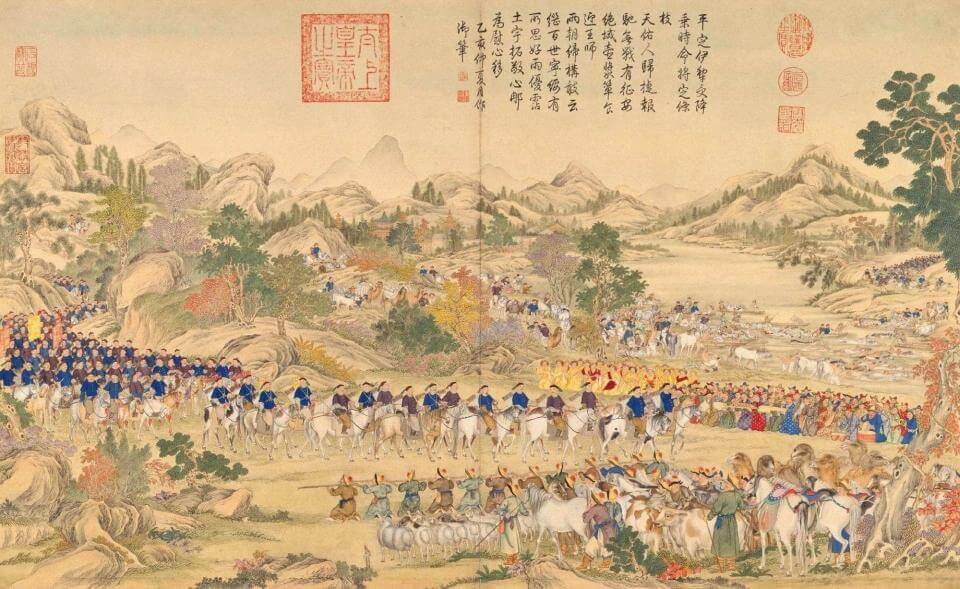 the painting "Receiving the surrender of the Ili" depicts the Qing army reaching what is now Yining on the Ili river in AD 1755
the painting "Receiving the surrender of the Ili" depicts the Qing army reaching what is now Yining on the Ili river in AD 1755
The Kangxi Emperor undertook further efforts to reform his empire's tax system. The results of a great survey of the empire that had taken place in AD 1712 were used as the basis for this tax reform. It had determined who privately owned land within the empire and fixed the tax rates upon the results in perpetuity! This "tax edict of 1712" would eventually lead to serious financial problems for the Qing government in later times.
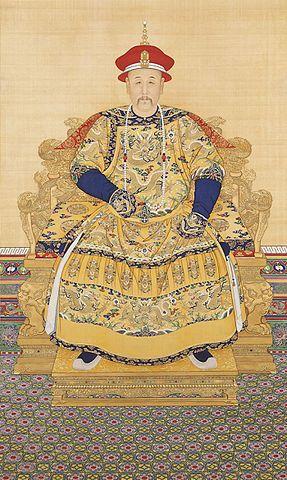 portrait of the Yongzheng Emperor in court dressWhen the Kangxi Emperor died in AD 1722 after having reigned for 60 years, he was succeeded by his son Yinzhen under peculiar circumstances. Yinzhen was named in an edict that had supposedly been written by the Kangxi Emperor on his deathbed. However, many believed this edict to have been forged. After ascending the throne as the Yongzheng Emperor, Yinzhen had many of his other brothers imprisoned, exiled or even murdered!
portrait of the Yongzheng Emperor in court dressWhen the Kangxi Emperor died in AD 1722 after having reigned for 60 years, he was succeeded by his son Yinzhen under peculiar circumstances. Yinzhen was named in an edict that had supposedly been written by the Kangxi Emperor on his deathbed. However, many believed this edict to have been forged. After ascending the throne as the Yongzheng Emperor, Yinzhen had many of his other brothers imprisoned, exiled or even murdered!
The Yongzheng Emperor's reign was marked by his efforts to make the administration of the Qing empire more efficient and effective. Streamlining the country's financial system turned out to be a major obstacle.
Already in the 1720s and at least partially due to the tax edict of 1712, major problems in the local collection of taxes and their subsequent transmission to the capital had become apparent, resulting in lower than anticipated tax revenue streams into the imperial treasury.
Until then, tax collection was an inefficient multi-stage process that started with their collection at the local level. That was then followed with the forwarding of the collected tax revenues to the provincial centers, where the various tax streams were then consolidated before being sent to the imperial court at Beijing. The imperial treasury then allocated the respectively needed financial resources to the various local administrations and these allocated streams were then sent to the provincial centers again and from there to the localities.
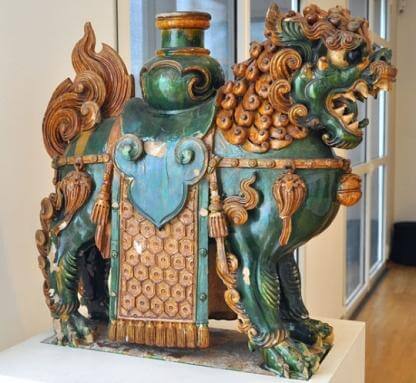 glazed temple roof figure of Mañjuśrī's lion from the 17th or 18th centurySuch a complicated multi-stage process that involved so many different officials provided ample opportunities for corruption at every level. Furthermore, local officials enriched themselves by charging various additional irregular fees and surcharges at the local level (for example for the smelting of silver into silver bars) that weren't listed in the official tax records. The Yongzheng Emperor tried to eliminate these irregular local charges and various other abuses of the system and tried to reform it in a way that improved the tax revenue flow to the central government.
glazed temple roof figure of Mañjuśrī's lion from the 17th or 18th centurySuch a complicated multi-stage process that involved so many different officials provided ample opportunities for corruption at every level. Furthermore, local officials enriched themselves by charging various additional irregular fees and surcharges at the local level (for example for the smelting of silver into silver bars) that weren't listed in the official tax records. The Yongzheng Emperor tried to eliminate these irregular local charges and various other abuses of the system and tried to reform it in a way that improved the tax revenue flow to the central government.
At first, the Yongzheng Emperor sent out officials with instructions to local administrators in certain test provinces at the empire's geographical center. These imperial officials had to make sure that the collected tax revenue was properly handled and recorded. To improve efficiency, the emperor allowed local administrators in these test provinces to retain a certain amount of the collected taxes in order to finance their local administration. This new streamlined system worked quite well in the test provinces at the center of China in the 1720s. When the emperor tried to expand the system nationwide in the 1730s however, he encountered such fervent resistance from local elites and literati officials that he eventually decided to abandon this new system in frustration.
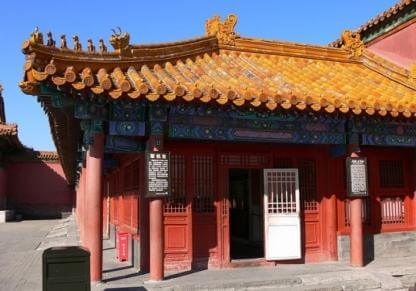 duty office of the Grand Council at the Forbidden City in BeijingThe Yongzheng Emperor's other reforms were more successful though. Under his leadership, the Grand Council replaced the Grand Secretariat (that continued to fulfil an administrative role but without much policy-formulating power) as the leading policy-formulating and consultative institution of the empire. The Grand Council consisted of 3 - 9 individual members that were all directly appointed by the emperor.
duty office of the Grand Council at the Forbidden City in BeijingThe Yongzheng Emperor's other reforms were more successful though. Under his leadership, the Grand Council replaced the Grand Secretariat (that continued to fulfil an administrative role but without much policy-formulating power) as the leading policy-formulating and consultative institution of the empire. The Grand Council consisted of 3 - 9 individual members that were all directly appointed by the emperor.
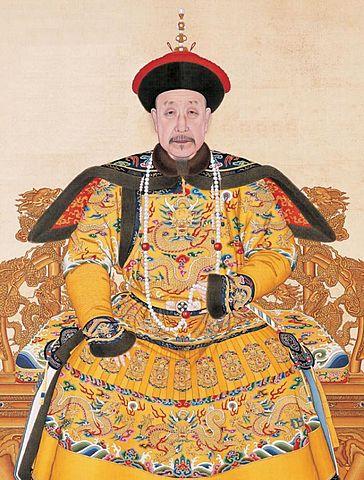 portrait of the Qianlong Emperor in court dressThe Yongzheng Emperor also showed the benevolent side of his character by undertaking measures that alleviated and even normalized the social status and living conditions of certain groups within society which had previously been treated as social outcasts.
portrait of the Qianlong Emperor in court dressThe Yongzheng Emperor also showed the benevolent side of his character by undertaking measures that alleviated and even normalized the social status and living conditions of certain groups within society which had previously been treated as social outcasts.
When the Yongzheng Emperor died in AD 1735, he was succeeded by one of his sons who went on to reign as the Qianlong Emperor (AD 1711 - 1799) until AD 1795. The Qianlong Emperor's reign is now seen as the peak time of the Qing dynasty (and possibly Chinese civilization until then). He was a hands-on ruler that personally oversaw many areas of his domain, whether administrative or military affairs, the economy and the tax system or the doings of his appointed officials! He also benefited from the work of his predecessors since many projects that had been started earlier came to fruition during his reign.
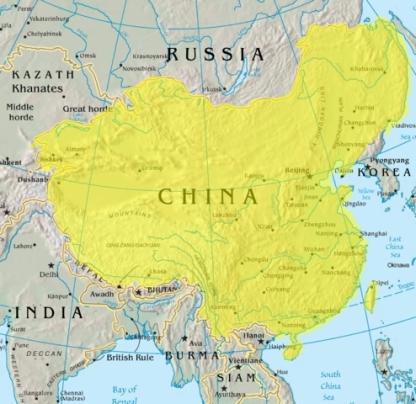 map of the Qing Dynasty empire in AD 1765By the 1770s, the Qianlong Emperor had completed the Kangxi Emperor's earlier efforts to incorporate the Western Mongol tribes into the Qing empire through a combination of military campaigns and diplomacy. The Qianlong Emperor also deepened the political involvement with Tibet which the Manchus had already incorporated within their empire through their alliance with the Mongols. It was during the Qianlong Emperor's reign that the Qing empire reached its greatest extent, incorporating territories that now belong to Mongolia, far-eastern Russia and some Central Asian countries.
map of the Qing Dynasty empire in AD 1765By the 1770s, the Qianlong Emperor had completed the Kangxi Emperor's earlier efforts to incorporate the Western Mongol tribes into the Qing empire through a combination of military campaigns and diplomacy. The Qianlong Emperor also deepened the political involvement with Tibet which the Manchus had already incorporated within their empire through their alliance with the Mongols. It was during the Qianlong Emperor's reign that the Qing empire reached its greatest extent, incorporating territories that now belong to Mongolia, far-eastern Russia and some Central Asian countries.
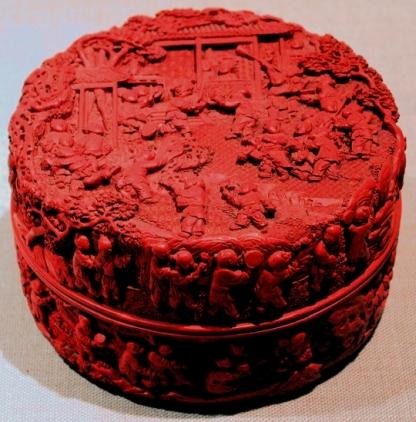 Qing dynasty lacquer box from the Qianlong periodThe Qianlong Emperor abdicated in AD 1795 since he didn't want to be on the throne longer than his grandfather, the Kangxi Emperor! By the end of the 18th century, the population of the empire had already increased to about 400 million people. The country manufactured about 25 percent of the global economic output at that time and many Chinese products like ceramics, lacquerware, tea and silk were sold all around the world. The Qing empire was then probably the most prosperous country in the world. However, its development and people's standard of living began to stagnate by the end of the 18th century. Progress in agriculture and manufacturing had reached a plateau. Agricultural output also couldn't be increased much further with the amount of arable land, farming techniques and labour that were available. Productivity in manufacturing was limited by the existing technologies as well.
Qing dynasty lacquer box from the Qianlong periodThe Qianlong Emperor abdicated in AD 1795 since he didn't want to be on the throne longer than his grandfather, the Kangxi Emperor! By the end of the 18th century, the population of the empire had already increased to about 400 million people. The country manufactured about 25 percent of the global economic output at that time and many Chinese products like ceramics, lacquerware, tea and silk were sold all around the world. The Qing empire was then probably the most prosperous country in the world. However, its development and people's standard of living began to stagnate by the end of the 18th century. Progress in agriculture and manufacturing had reached a plateau. Agricultural output also couldn't be increased much further with the amount of arable land, farming techniques and labour that were available. Productivity in manufacturing was limited by the existing technologies as well.
After the Qianlong Emperor's reign had ended and especially at the beginning of the 19th century, China's development reached a turning point. That was due to a combination of factors both from the inside and outside. Inside China, the rapid expansion of the Chinese population began to create major obstacles. With a population of about 400 million people at the beginning of the 19th century but a limited amount of arable land (even in present times, China's amount of arable land lies only slightly above the required minimum to ensure food security), China's development began to push against ecological limits. The agricultural yield couldn't be increased much further with the established farming methods and available technologies.
Furthermore, the country's administration was impeded by elites (literati and merchants), who were more concerned with protecting their own interests then the common good. Especially the literati elite had repeatedly resisted the government's efforts to extract greater fiscal revenues from them. The Qing emperors that ruled the country after the Qianlong Emperor's abdication didn't show the strong leadership of their three predecessors (the Kangxi, Yongzheng and Qianlong Emperor) either. During the reigns of these three powerful and charismatic emperors, there had been hardly any insurrections against Qing leadership at all.
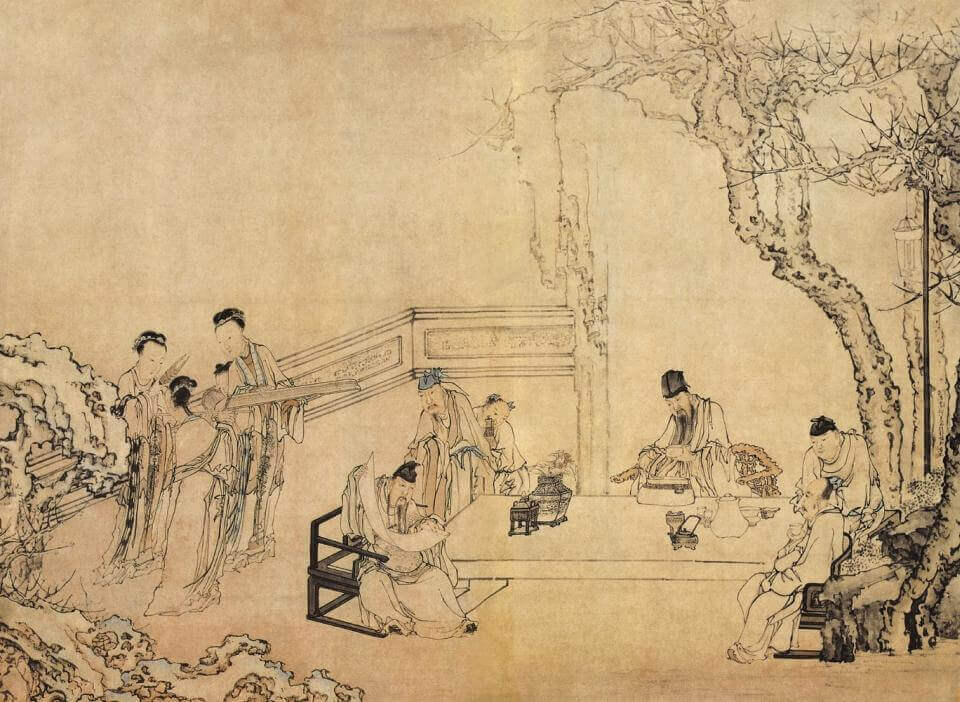 Qing dynasty painting by Huang Shen, showing a gathering of Chinese literati sitting in a banquet composing poetry, eating and listening to music
Qing dynasty painting by Huang Shen, showing a gathering of Chinese literati sitting in a banquet composing poetry, eating and listening to music
At the end of the 18th and especially during the early 19th century, resentment among the population against their wealthy overlords (landlords and other wealthy families, wealthy government officials) began to fester again, leading to violent rebellions. In addition, some mystical movements among the peasantry began to appear as well. One of them would plunge China into a terrible civil war in the mid-19th century (more on that later).
Outside pressures arose during the same period and came particularly from England, which tried to bring China to acquiesce to their demands for equitable terms of free trade. Trade between China and the West had already existed for a long time, but was heavily regulated from the Chinese side.
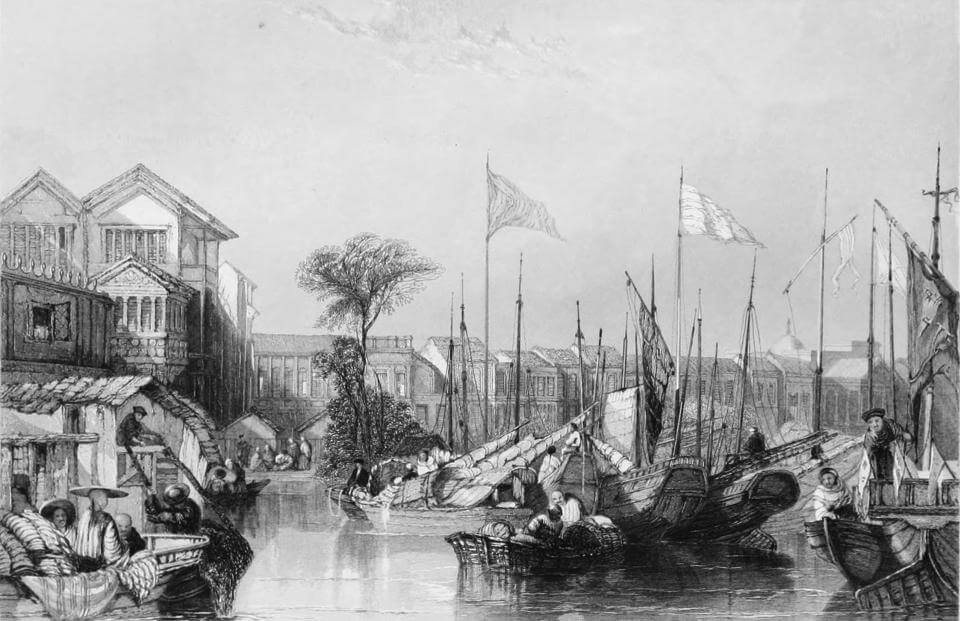 area for Western merchants in Canton
area for Western merchants in Canton
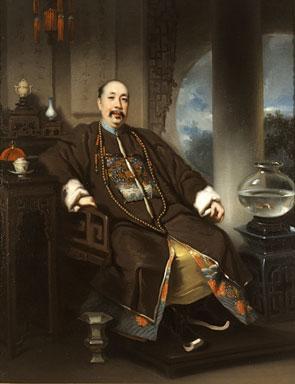 portrait of the Hong merchant MowquaOne important regulation from the middle of the 18th century on was that trade with China could only legally take place at one single location, the port of Canton (now Guangzhou) in the southeast of China. The Canton-based Cohong system further mandated that all trade had to be done through a Chinese middleman. These Chinese middlemen - known as the Hong merchants - were officially licensed by the Qing government to broker trade deals between Western and Chinese businessmen for which they received a commission.
portrait of the Hong merchant MowquaOne important regulation from the middle of the 18th century on was that trade with China could only legally take place at one single location, the port of Canton (now Guangzhou) in the southeast of China. The Canton-based Cohong system further mandated that all trade had to be done through a Chinese middleman. These Chinese middlemen - known as the Hong merchants - were officially licensed by the Qing government to broker trade deals between Western and Chinese businessmen for which they received a commission.
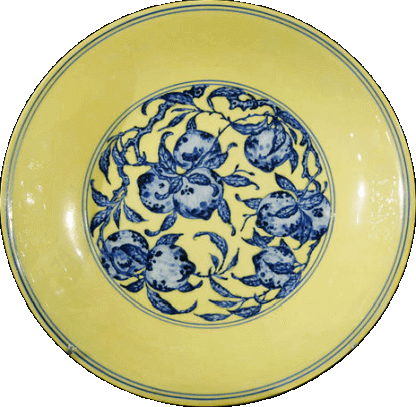 glazed porcelain plate from the reign period of the Yongzheng EmperorThe second important regulation was that the Chinese only accepted silver as payment for their high-quality manufactured goods (particularly tea, silk, lacquerware and ceramics). That resulted in huge silver inflows into their domestic economy. Even though British and other Western merchants made great profits at home selling these Chinese goods, they became increasingly unhappy by the stubborn insistence of the Chinese upon the payment in silver, which had quickly resulted in a precipitous decline of the silver reserves of the British empire.
glazed porcelain plate from the reign period of the Yongzheng EmperorThe second important regulation was that the Chinese only accepted silver as payment for their high-quality manufactured goods (particularly tea, silk, lacquerware and ceramics). That resulted in huge silver inflows into their domestic economy. Even though British and other Western merchants made great profits at home selling these Chinese goods, they became increasingly unhappy by the stubborn insistence of the Chinese upon the payment in silver, which had quickly resulted in a precipitous decline of the silver reserves of the British empire.
Already before the Napoleonic wars in AD 1793, Britain had sent a diplomatic mission to China with the goal of convincing the Qing government to allow normal and equitable trade relations. Adam Smith's "The Wealth of Nations" (which propagated a free market economy in which the government doesn't intervene in the economy and let the markets function freely) had gained great support among the mercantile class since its publication in AD 1776.
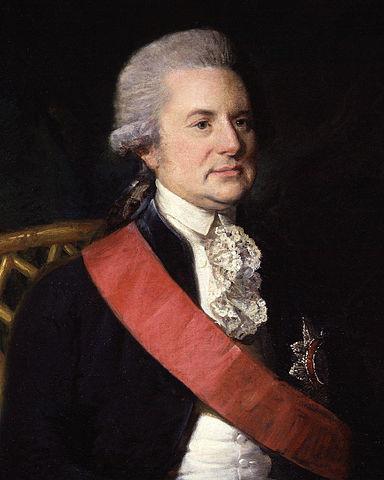 Portrait of Lord George MacartneyThe Qianlong Emperor had received the British mission (led by Lord George Macartney) in AD 1793 politely and bestowed great gifts upon them, but refused their demands for free trade insisting that the Chinese would continue to set the terms under which trade could proceed.
Portrait of Lord George MacartneyThe Qianlong Emperor had received the British mission (led by Lord George Macartney) in AD 1793 politely and bestowed great gifts upon them, but refused their demands for free trade insisting that the Chinese would continue to set the terms under which trade could proceed.
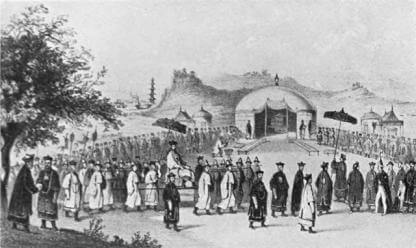 the Qianlong Emperor's reception of Lord MacartneyThis refusal came to be symbolized by the Qianlong Emperor's written reply to King George the Third:
the Qianlong Emperor's reception of Lord MacartneyThis refusal came to be symbolized by the Qianlong Emperor's written reply to King George the Third:
". . . although our Celestial Empire possesses all things in prolific abundance and lacks no product within its own borders. There was therefore no need to import the manufactures of outside barbarians in exchange for our own produce."
The Chinese refused the British request for free trade a second time in AD 1816 (after the Napoleonic Wars had ended). That didn't discourage British merchants (and other Western traders) in trying to find a way to make the trade between China and the West more equitable. However, at first they didn't have any high-quality English goods to offer in exchange. That changed with the dawn of the industrial revolution in England at the end of the 18th and the beginning of the 19th century. Now, England became the mass producer of a large variety of different products of reasonable quality that could be produced cheaply.
Producing much more than the domestic English economy could absorb, new markets for these products needed to be found and China lured as the vastest potential market of all with its large territory and population. English merchants tried to find access to this vast market for their products. At the beginning of the 19th century, its traders had found a questionable but profitable way: the opium trade! Opium had been known in China for a long time already (it was also grown in small quantities in China's southwestern regions), both for its medicinal uses and as a recreational drug. British merchants begun to ship increasing amounts of opium from their territories in Bengal (Eastern India) through ports in Southeast Asia to Canton.
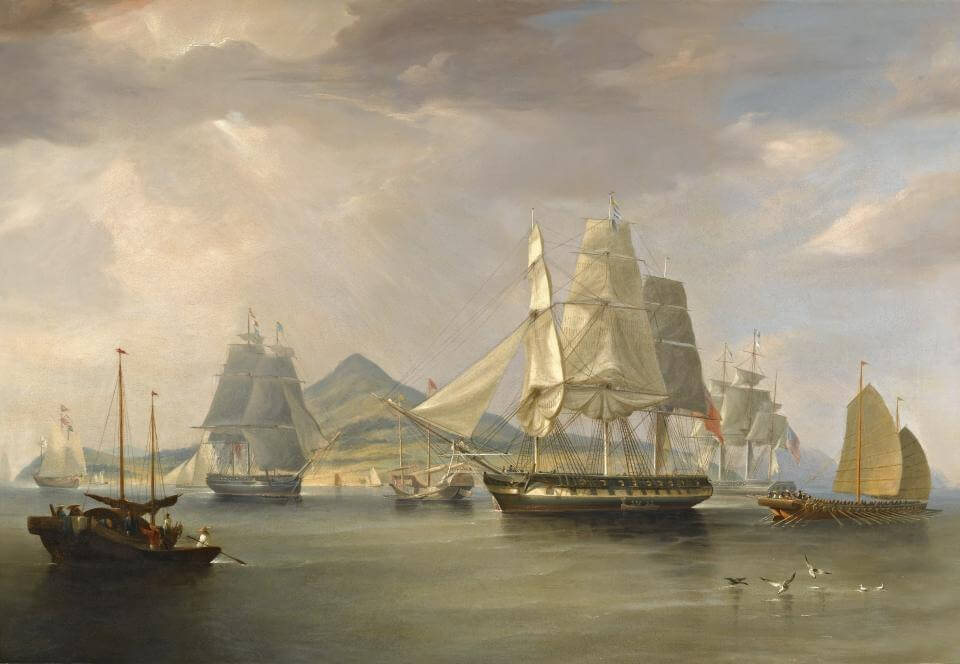 William John Huggins' oil painting "The opium ships at Lintin, China, 1824"
William John Huggins' oil painting "The opium ships at Lintin, China, 1824"
In the Indian Bengal region, land that had previously been used for the growth of cotton had been converted to the cultivation of opium by the British. By this measure, the British had wanted to prevent potential competition of the Indian cotton industry with the cotton and textile industry in England. The supply of opium skyrocketed as a result (which made opium cheaper to buy).
British and other Western merchants quickly realized the huge demand for it in the south of China, particularly among the poorer classes of Chinese society. Between AD 1816 and 1830, the volume of opium that entered the Chinese market through the port of Canton increased significantly every year and millions of Chinese became opium addicts. The fact that the Yongzheng Emperor had already imposed regulations on opium in the 1730s that had outlawed its use as a recreational drug wasn't an effective deterrent in the absence of effective controls.
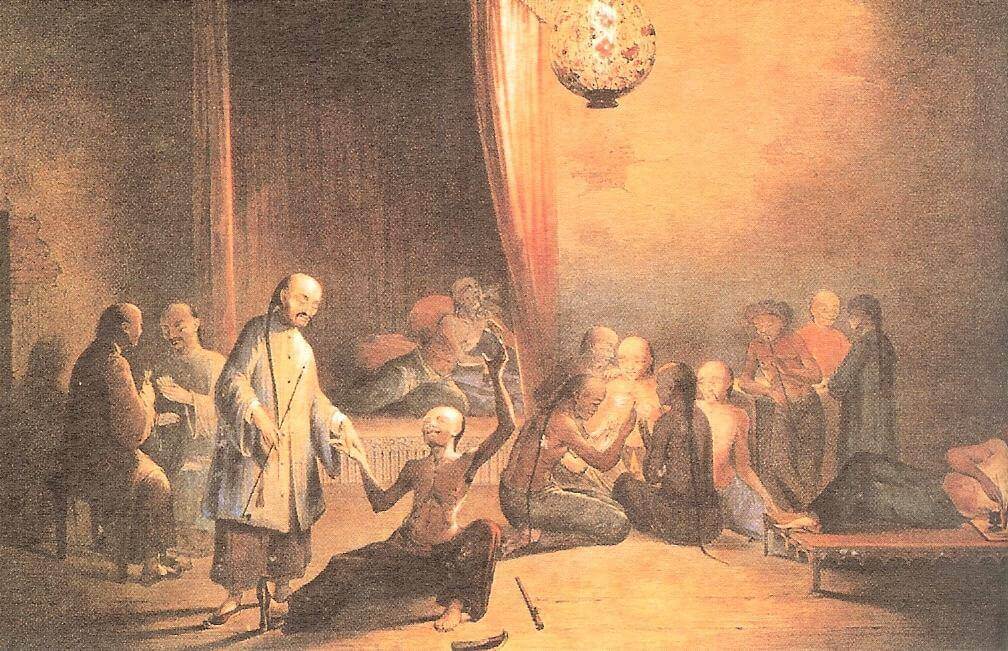 Chinese opium addicts in the 18th century
Chinese opium addicts in the 18th century
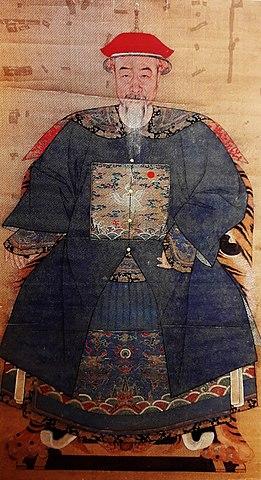 mid-18th century portrait of a Qing dynasty officialAs a result of increasing opium consumption among the population, labour productivity within the Chinese economy declined sharply and social problems like crime and anti-social behaviour rose dramatically in South China. Economic problems followed as well, since British and other Western merchants recognized the huge demand for opium as an opportunity to reverse the silver flows.
mid-18th century portrait of a Qing dynasty officialAs a result of increasing opium consumption among the population, labour productivity within the Chinese economy declined sharply and social problems like crime and anti-social behaviour rose dramatically in South China. Economic problems followed as well, since British and other Western merchants recognized the huge demand for opium as an opportunity to reverse the silver flows.
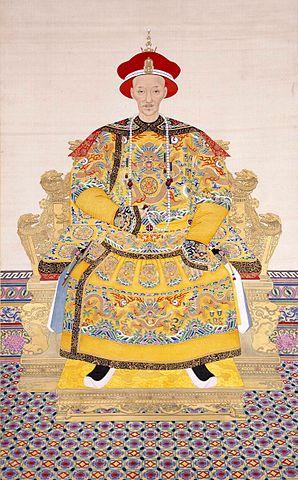 Qing dynasty portrait of the Daoguang EmperorFrom the 1810s to the 1830s, the trade surplus in silver that China had amassed reversed to a trade deficit. By the 1830s, the increasing silver outflows out of the Chinese economy had resulted in a shortage of capital for investment and to dramatic price fluctuations within the Chinese economy. Since taxes had to be paid in silver which was flowing out of the economy at alarming rates, problems with the collection of taxes arose as well and led to declining tax revenues of the Qing state. The Qing government got into trouble to find the financing to maintain normal functions of government. Even critical infrastructure within the country deteriorated due to a lack of funding for necessary maintenance operations (for example the dredging of the Grand Canal that had silted up in some parts). These problems became more and more serious quickly, but the Qing's inflexible bureaucracy was at first unable to come up with new and practical solutions to ameliorate the situation.
Qing dynasty portrait of the Daoguang EmperorFrom the 1810s to the 1830s, the trade surplus in silver that China had amassed reversed to a trade deficit. By the 1830s, the increasing silver outflows out of the Chinese economy had resulted in a shortage of capital for investment and to dramatic price fluctuations within the Chinese economy. Since taxes had to be paid in silver which was flowing out of the economy at alarming rates, problems with the collection of taxes arose as well and led to declining tax revenues of the Qing state. The Qing government got into trouble to find the financing to maintain normal functions of government. Even critical infrastructure within the country deteriorated due to a lack of funding for necessary maintenance operations (for example the dredging of the Grand Canal that had silted up in some parts). These problems became more and more serious quickly, but the Qing's inflexible bureaucracy was at first unable to come up with new and practical solutions to ameliorate the situation.
The Qing government realized the unprecedented economic and social problems that arose from the opium trade as well. In trying to control or eliminate the opium trade, the Qing government repeatedly sent letters of protest to the British authorities, traders and representatives of merchants in Canton that lamented the opium trade's adverse effects on the Chinese society and economy. The Daoguang Emperor (AD 1782 - 1850) tried to address this problem by calling on his officials to debate possible solutions to this dilemma.
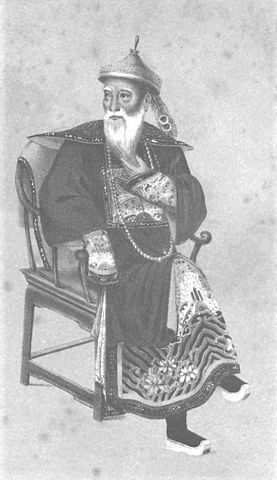 Qing dynasty imperial commissioner Lin ZexuOne of the more experienced among those court officials caught the emperor's attention when he submitted a memorial on how to deal with this problem. The official Lin Zexu (AD 1785 - 1850) had in fact already distinguished himself positively on prior occasions, specifically through his flexibility and creativity in dealing with the often unruly Muslim population in Central Asia. Lin Zexu's memorial proposed to address the huge opium demand by offering rehabilitation and job-retraining programs for opium addicts.
Qing dynasty imperial commissioner Lin ZexuOne of the more experienced among those court officials caught the emperor's attention when he submitted a memorial on how to deal with this problem. The official Lin Zexu (AD 1785 - 1850) had in fact already distinguished himself positively on prior occasions, specifically through his flexibility and creativity in dealing with the often unruly Muslim population in Central Asia. Lin Zexu's memorial proposed to address the huge opium demand by offering rehabilitation and job-retraining programs for opium addicts.
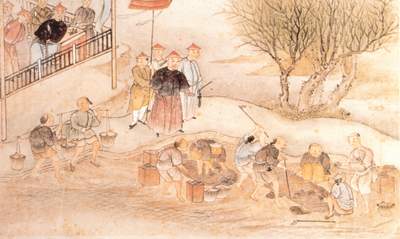 picture showing the destruction of opium in dug trenchesTo curb the supply of opium, Lin Zexu proposed a strict prohibition policy of all imports and sales. After being named imperial commissioner in AD 1838, Lin Zexu travelled from Beijing to Canton in the winter of 1838/1839. In the spring of AD 1839, he quickly started to take action towards eradicating the opium trade. Upon his order, large quantities of opium were confiscated from various warehouses (called godowns). These warehouses were used by foreign traders to store their newly arrived cargo before it was shipped towards the interior of the country. After seizing the opium, Lin Zexu had the entire lot covered with lime in dug trenches before burning it.
picture showing the destruction of opium in dug trenchesTo curb the supply of opium, Lin Zexu proposed a strict prohibition policy of all imports and sales. After being named imperial commissioner in AD 1838, Lin Zexu travelled from Beijing to Canton in the winter of 1838/1839. In the spring of AD 1839, he quickly started to take action towards eradicating the opium trade. Upon his order, large quantities of opium were confiscated from various warehouses (called godowns). These warehouses were used by foreign traders to store their newly arrived cargo before it was shipped towards the interior of the country. After seizing the opium, Lin Zexu had the entire lot covered with lime in dug trenches before burning it.
The British merchants, who were therefore faced with huge economic losses, demanded the British military to take action against this perceived injustice. The British crown quickly promised the merchants swift compensation out of its own treasury. Many if not most British and other Western merchants still erroneously thought at that time that the destruction of opium had been a one-time event that was meant to demonstrate the power and decisiveness of the Chinese Qing state. However, Lin Zexu had no intention to let the opium trade resume its previous operations. He quickly demonstrated this intent by having a second batch of opium confiscated without compensation, before burning it all at Humen beach in June of AD 1839.
The British debated suitable measures of retaliation in parliament, but framed the debate in terms of their preferred economic doctrine of free trade (downplaying the unwelcome fact that it was free drug trade that they sought).
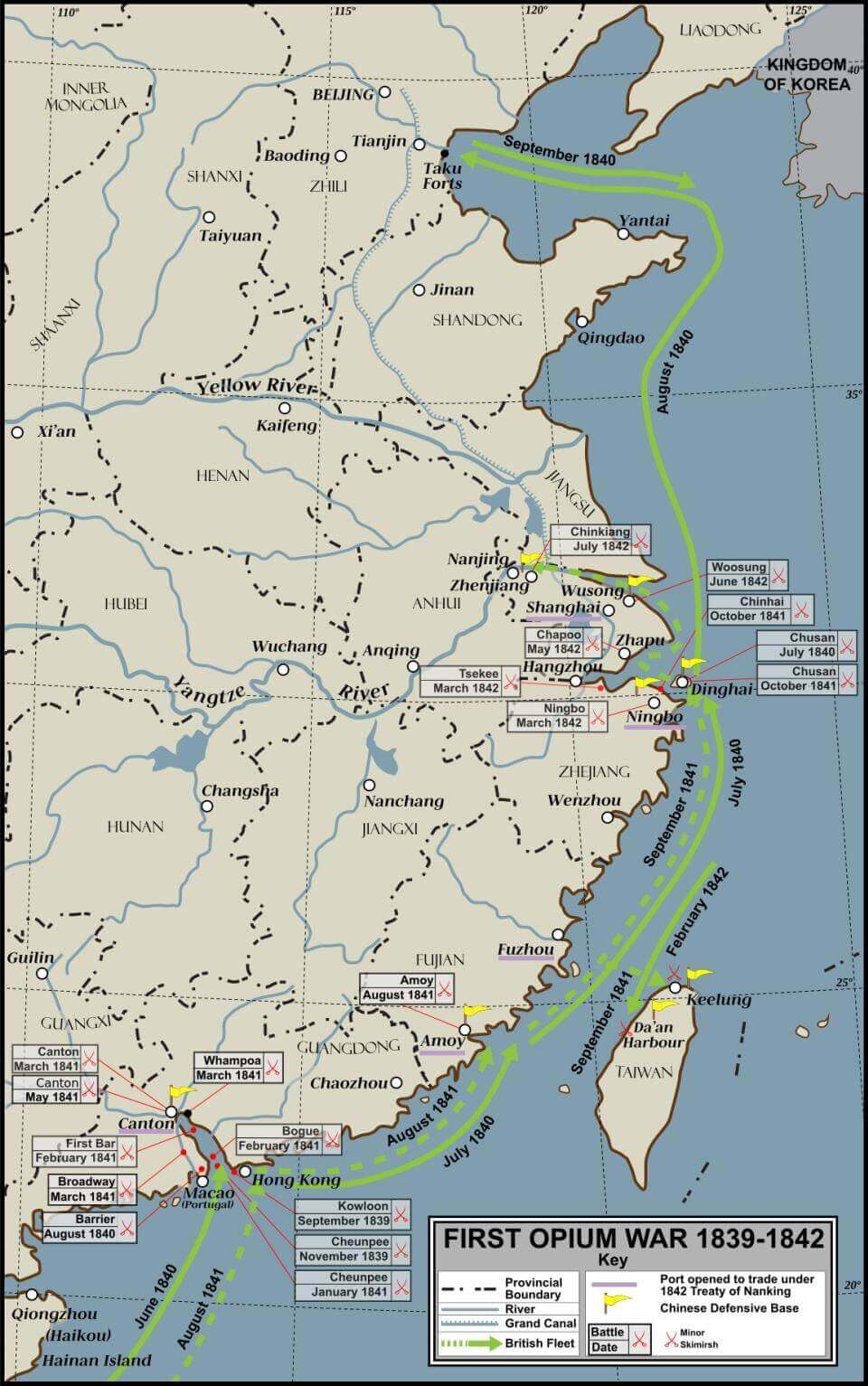 map providing an overview of conflicts during the First Opium War between 1839 and 1842
map providing an overview of conflicts during the First Opium War between 1839 and 1842
In November of AD 1839, the First Opium War broke out in which the British navy repeatedly defeated the Chinese in humiliating ways. Benefiting from their modern weaponry that Britain could produce thanks to the industrial revolution and which the Chinese did not possess, the British navy sailed from their base at Hong Kong's natural Victoria Harbour almost unchallenged to various ports along the South China coast. These were then shelled with artillery fire without regards to the mostly poor and unprotected Chinese civilian population (of whom the majority had usually fled). The Qing government however only felt compelled to enter into negotiations with the British when their fleet seemed to approach the imperial capital Beijing.
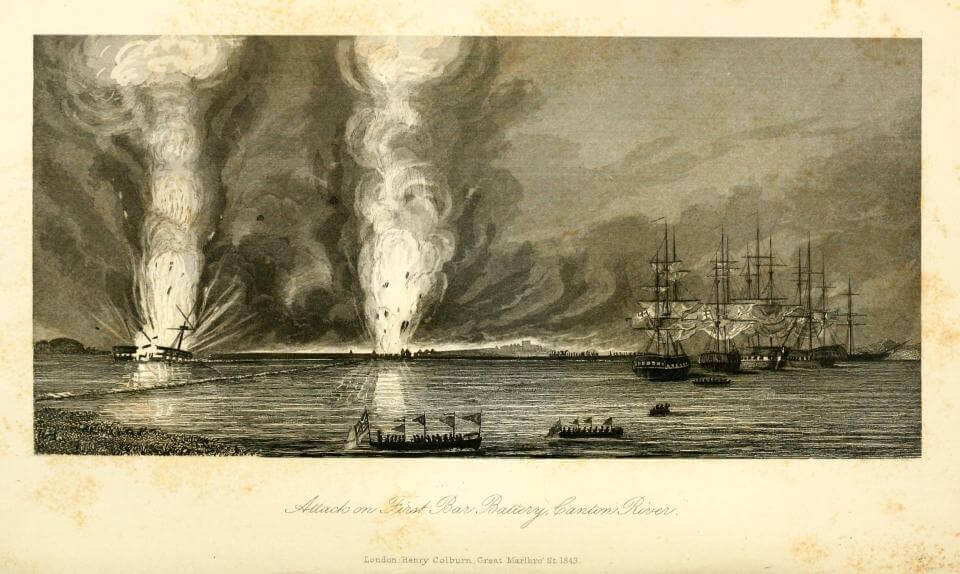 historic postcard showing the Battle of First Bar on the Canton River during the First Opium War
historic postcard showing the Battle of First Bar on the Canton River during the First Opium War
When these negotiations seemed to drag on for too long without desirable results for the British, their fleet started a second round of military campaigns which brought them further north and even closer to Beijing. Thereby forced to reach a settlement, the Chinese Qing government agreed to humiliating concessions in the Treaty of Nanjing which was signed by both governments on the 29th of August 1842.
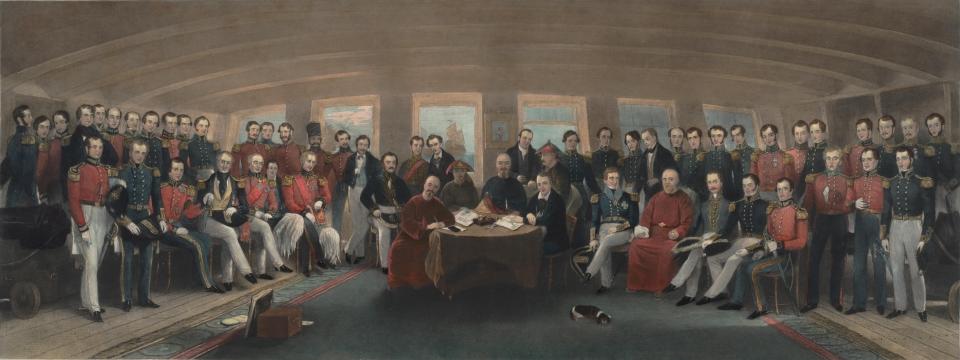 the signing and sealing of the Treaty of Nanjing
the signing and sealing of the Treaty of Nanjing
In this treaty, China conceded to open ports along the South China coast to British traders. Previously, all trade had to be conducted through Cohong brokers (Chinese middlemen) in Canton. The Treaty of Nanjing allowed the British to trade freely with anyone in the ports of Canton and the newly opened trade ports in Xiamen (back then still named Amoy), Fuzhou, Ningbo and Shanghai.
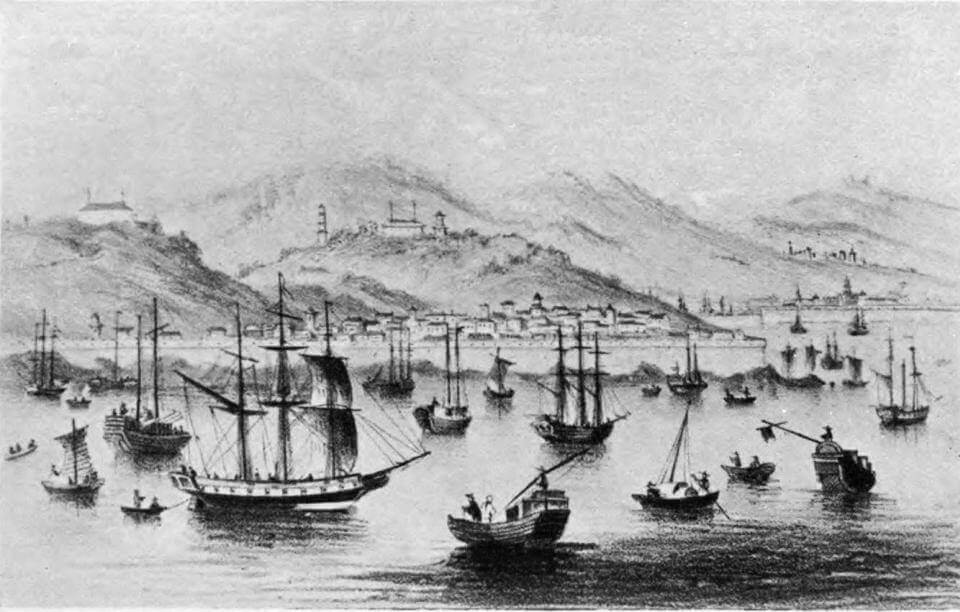 Amoy (today the city of Xiamen) shortly after opening the port to foreign trade
Amoy (today the city of Xiamen) shortly after opening the port to foreign trade
One further famous result of the Treaty of Nanjing was the official cession of the island of Hong Kong to Britain in perpetuity. The British crown colony Hong Kong was later expanded to include the Kowloon side on the mainland (in AD 1860 after the Second Opium War) as well as the New Territories (in AD 1898 for a 99-year lease). On the 1st of July 1997, Hong Kong was returned to the People's Republic of China.
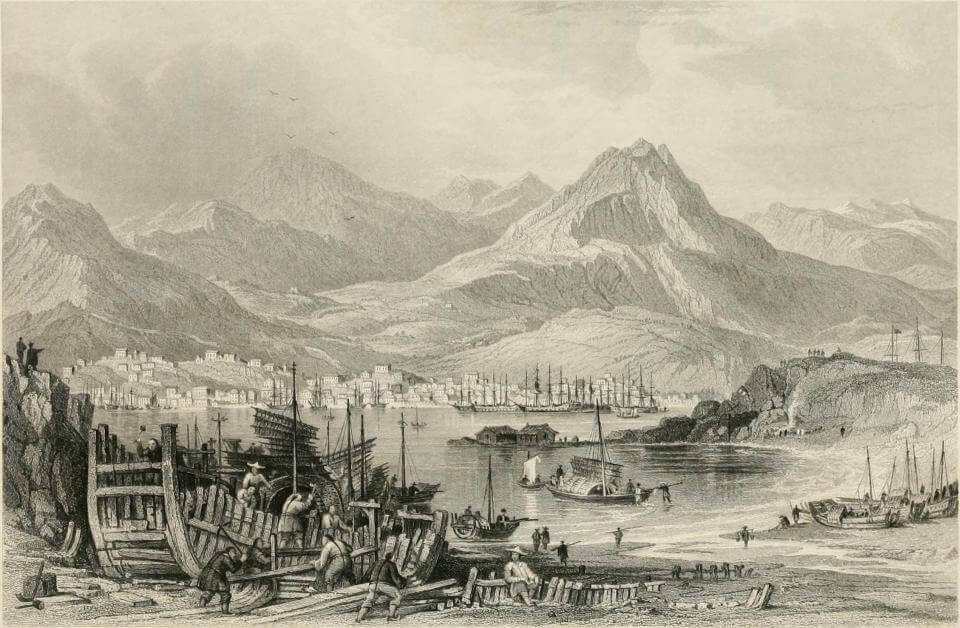 view of Hong Kong Island from the Kowloon peninsula around AD 1840
view of Hong Kong Island from the Kowloon peninsula around AD 1840
The Treaty of Nanjing also established the principle of extraterritoriality, which meant that British citizens in China remained subject to the laws of Britain and not of China. Whereas the Chinese authorities previously had the power to arrest and prosecute for example violent or otherwise misbehaving British sailors at the port of Canton, that police power now remained in the exclusive hands of the British authorities that were stationed there.
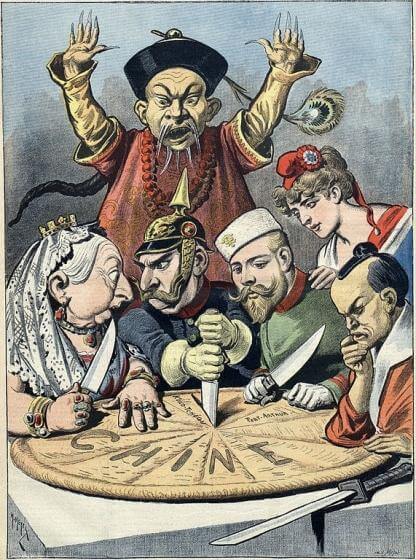 French political caricature from the 1890s showing the imperialist powers of England, Germany, Russia, France and Japan (from left) carving up China like a pieDuring the following years, other Western powers like the United States (Treaty of Wanghia in AD 1844) and France (Treaty of Whampoa in AD 1844) signed treaties with the Chinese Qing government as well. Further concessions that the Chinese were forced to make in these treaties were the opening of additional treaty ports, the license for foreign missionaries to operate freely within China and the establishment of the "most-favoured-nation clause". This clause automatically extended any concessions made by the Chinese to one foreign treaty country to all other foreign treaty countries as well.
French political caricature from the 1890s showing the imperialist powers of England, Germany, Russia, France and Japan (from left) carving up China like a pieDuring the following years, other Western powers like the United States (Treaty of Wanghia in AD 1844) and France (Treaty of Whampoa in AD 1844) signed treaties with the Chinese Qing government as well. Further concessions that the Chinese were forced to make in these treaties were the opening of additional treaty ports, the license for foreign missionaries to operate freely within China and the establishment of the "most-favoured-nation clause". This clause automatically extended any concessions made by the Chinese to one foreign treaty country to all other foreign treaty countries as well.
Naturally, these unequal treaties were deeply humiliating for the Qing government and the Chinese soul. China had always seen itself as the center of the known world and all outsiders more or less as barbarians. Even though the extension of trade that followed the opening of all these treaty ports had positive economic effects as well, it immediately exacerbated China's drug problems through the resuming opium trade.
After China's defeat in the First Opium War that resulted in the humiliating Treaty of Nanjing (followed by further treaties with other nations), the opium trade not only resumed but even increased, thanks to the access that Britain now had to several ports along the South China Sea (and not only the port of Canton as before). Opium addiction spread to even more areas within China and exacerbated social problems in these areas. The economic situation deteriorated further as well, due to the continuing silver outflow out of the Chinese economy.
The forced opening of all those treaty ports along the Chinese coast created new economic problems as well, since it resulted in a reorientation of traditional trade routes. Britain and other Western powers now concentrated their trade efforts solely upon the coastal areas and neglected the interior markets. Many Chinese labourers who had been involved in the transportation of goods to/within the interior of China lost their jobs. Various other negative effects of the opening of the treaty ports plagued Southern China. The stresses of overpopulation, combined with a limited potential for further economic expansion, created conditions in China by the middle of the 19th century that were ideal for the ferment of social unrest and rebellion.
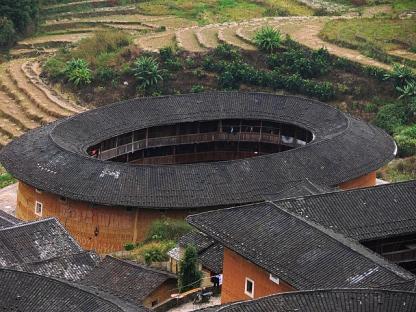 oval-shaped Tulou buildingThe Taiping Rebellion that plunged China into civil war by the 1860s was closely connected with the story of one man who grew up in a Hakka family (called gejia = "guest families" by the Chinese) in Southern China during the early 19th century. The Hakka were (and are!) a local population in Southern China that had moved there from China's northern areas after the initial waves of migration and that proudly retained its own distinctive cultural traditions. That led to them sometimes being regarded with scorn by the local long-established families of other social groups, due to the Hakkas' self-reliance and strong internal fellowship and therefore perceived lack of assimilation into local culture. One distinctive example for the Hakka people's marginalization and tight social cohesion are the fortress-like Tulou dwellings that they built in many areas. Due to their social standing as outsiders, the Hakka were more strongly affected by the negative consequences of the opening of the treaty ports and various other internal problems that the Qing state had to deal with at that time.
oval-shaped Tulou buildingThe Taiping Rebellion that plunged China into civil war by the 1860s was closely connected with the story of one man who grew up in a Hakka family (called gejia = "guest families" by the Chinese) in Southern China during the early 19th century. The Hakka were (and are!) a local population in Southern China that had moved there from China's northern areas after the initial waves of migration and that proudly retained its own distinctive cultural traditions. That led to them sometimes being regarded with scorn by the local long-established families of other social groups, due to the Hakkas' self-reliance and strong internal fellowship and therefore perceived lack of assimilation into local culture. One distinctive example for the Hakka people's marginalization and tight social cohesion are the fortress-like Tulou dwellings that they built in many areas. Due to their social standing as outsiders, the Hakka were more strongly affected by the negative consequences of the opening of the treaty ports and various other internal problems that the Qing state had to deal with at that time.
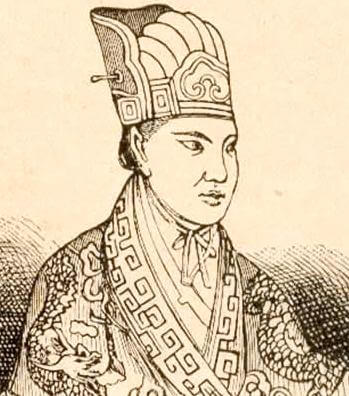 contemporary drawing of Hong Xiuquan (the leader of the Taiping Rebellion) around AD 1860These arising problems might have made the Hakka people more receptive to new and even unusual ideas. Hong Xiuquan (AD 1814 - 1864) grew up as the youngest son in a Hakka family that wasn't particularly wealthy. Nevertheless, his family had been able to let him be educated so that he could some day pass the highest level of the imperial examinations. His family must have certainly invested a lot of time, money and effort in their son's education in the hopes of having their fortunes lifted once he passed these exams. However, Hong Xiuquan must have gravely disappointed his parents by failing even the entry level examination every single time that he had tried.
contemporary drawing of Hong Xiuquan (the leader of the Taiping Rebellion) around AD 1860These arising problems might have made the Hakka people more receptive to new and even unusual ideas. Hong Xiuquan (AD 1814 - 1864) grew up as the youngest son in a Hakka family that wasn't particularly wealthy. Nevertheless, his family had been able to let him be educated so that he could some day pass the highest level of the imperial examinations. His family must have certainly invested a lot of time, money and effort in their son's education in the hopes of having their fortunes lifted once he passed these exams. However, Hong Xiuquan must have gravely disappointed his parents by failing even the entry level examination every single time that he had tried.
One of those times that he had gone to Canton to take the exam, he had received some Christian pamphlets from Western missionaries. Years later, after failing the exam yet again (for a fourth time!) despite his strenuous study efforts, he returned back home and had a sort of nervous breakdown and spent weeks mostly in bed, isolating himself from the world. During this time, he had dreams and visions of an old gentleman with a long white beard and a younger man with a dark beard who both talked to him in his visions. After he had sufficiently recovered, he reflected upon these visions and after consulting the Christian pamphlets again, he was struck by a revelation. The older man in his visions must have been God and the younger man Jesus! What's more, they had been telling him in his visions that he himself was the younger brother of Jesus and that it was his life mission to bring Christianity to the Chinese people!
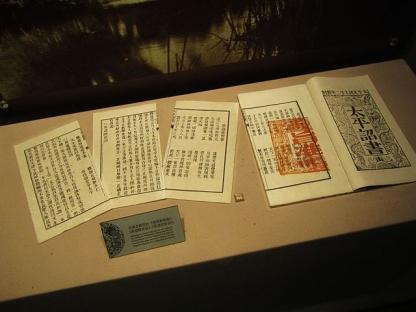 Writings by Hong XiuquanThereafter, Hong Xiuquan abandoned his lifelong plans of trying to pass the imperial examinations and his view of life changed to such a degree, that he henceforth saw China's Confucian system and imperial order as something that he had to strive to eliminate. To realize his new ambitions, Hong Xiuquan began to build up a self-led movement that sought to establish a heavenly kingdom on earth. This movement, that came to be known as the Taiping Tianguo (the "Heavenly Kingdom of Great Peace"), started in the late 1830s and the beginning of the 1840s as the "society of god worshippers".
Writings by Hong XiuquanThereafter, Hong Xiuquan abandoned his lifelong plans of trying to pass the imperial examinations and his view of life changed to such a degree, that he henceforth saw China's Confucian system and imperial order as something that he had to strive to eliminate. To realize his new ambitions, Hong Xiuquan began to build up a self-led movement that sought to establish a heavenly kingdom on earth. This movement, that came to be known as the Taiping Tianguo (the "Heavenly Kingdom of Great Peace"), started in the late 1830s and the beginning of the 1840s as the "society of god worshippers".
Many of Hong Xiuquan's initial followers were Hakka people like him, but the Taiping movement quickly grew beyond this group. The high degree of social cohesion that was common for the somewhat discriminated Hakka people must have helped to get the movement started. However, Hong Xiuquan was not content with creating a movement for the Hakka people alone and maintained the ambition to create a heavenly kingdom on earth for all Chinese people.
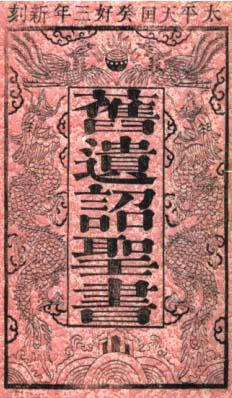 the Bible in classical Chinese, published by the Taiping Heavenly Kingdom in AD 1853Hong Xiuquan supposedly hadn't studied the Christian Bible at first. His knowledge of Christianity mostly derived from texts that he had received from missionaries. Later on, he studied Christianity more thoroughly and it was his continuing visions and strong personal conviction in his new mission that helped him to further develop the ideology of his movement. Through his strong personal charisma and faith in himself, he attracted a core of followers of different education levels and from different social strata (mostly rural peasants, but also wealthy merchants and even some local officials) around himself and established an utopian commune in rural western Guangdong province.
the Bible in classical Chinese, published by the Taiping Heavenly Kingdom in AD 1853Hong Xiuquan supposedly hadn't studied the Christian Bible at first. His knowledge of Christianity mostly derived from texts that he had received from missionaries. Later on, he studied Christianity more thoroughly and it was his continuing visions and strong personal conviction in his new mission that helped him to further develop the ideology of his movement. Through his strong personal charisma and faith in himself, he attracted a core of followers of different education levels and from different social strata (mostly rural peasants, but also wealthy merchants and even some local officials) around himself and established an utopian commune in rural western Guangdong province.
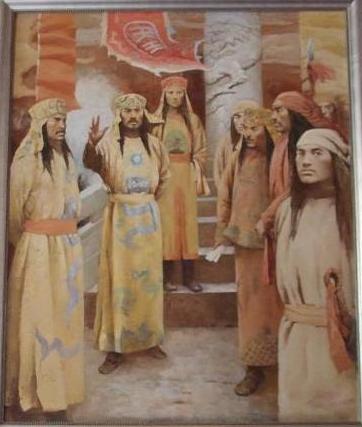 painting of the leaders of the Taiping RebellionWhereas hierarchical relationships defined the model of a Confucian well-ordered society that China aspired to, there was no hierarchy and no ranks in Hong Xiuquan's movement in the early days (except that he was the leader).
painting of the leaders of the Taiping RebellionWhereas hierarchical relationships defined the model of a Confucian well-ordered society that China aspired to, there was no hierarchy and no ranks in Hong Xiuquan's movement in the early days (except that he was the leader).
Even more radical was the abolition of all private property (everything was shared within the commune) and the segregation of men and women. There were separate dormitories for men and women as a measure to maintain sexual purity. Even families were broken up, as marriage was seen as just another hierarchical system within the disdained Confucian order (husbands and wives could meet each other on three days of every month though).
The comprehensive social system of the Taiping movement was basically an inversion of the dominating Confucian order in China and that might have contributed to its wide appeal. In the 1840s, the movement grew exponentially, both in terms of followers and territory. Hong Xiuquan's ambitions grew along with it, from leading a separate community that lived according to its own rules but within Chinese society, to building a movement that was powerful enough to overthrow the reigning Qing dynasty and establish a heavenly kingdom in China.
Though maintaining a rank-free army, the Taiping movement adopted a system of central leadership under which Hong Xiuquan became the Heavenly King. He was assisted by Wei Changhui (the North King), Feng Yunshan (the South King), Yang Xiuqing (the East King) and Xiao Chaogui (the West King). In AD 1850, Hong Xiuquan and his subordinate leaders began to act upon their ambitions and started a military campaign that saw the Taiping troops move north from Guangdong province and fight their way to Hunan province. Along their way, they repeatedly defeated the Qing armies in battle.
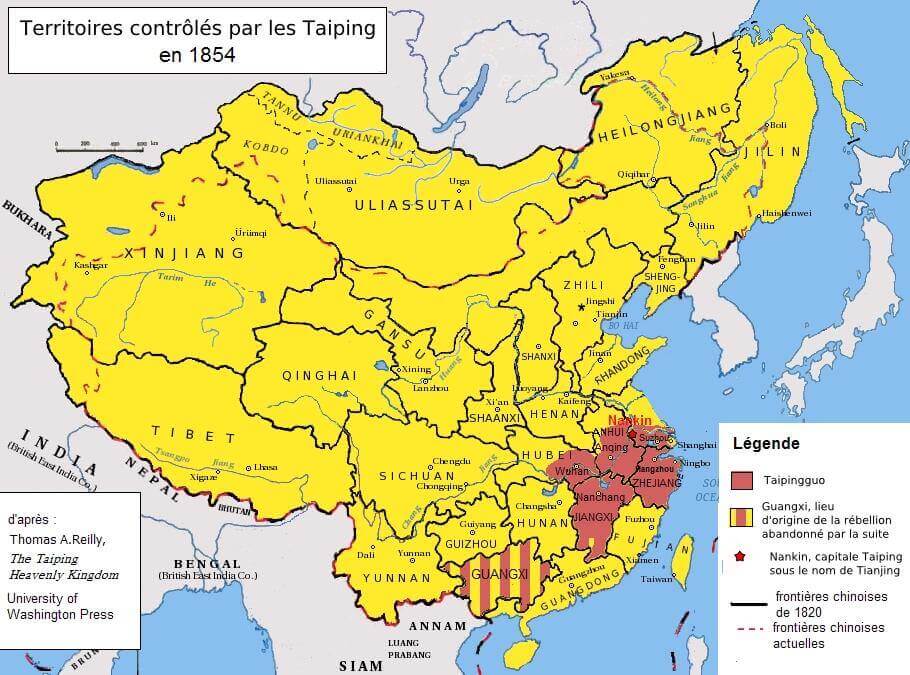 map showing the territory that was controled by the Taiping rebels in 1854 in red
map showing the territory that was controled by the Taiping rebels in 1854 in red
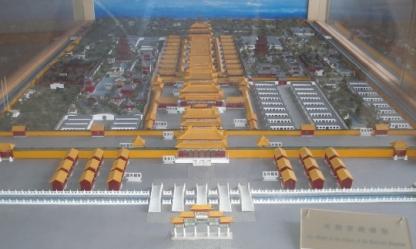 Model of the Palace of the Heavenly Kingdom in NanjingThe Taiping movement had a huge appeal to ordinary poor farmers and other marginalized parts of the population and therefore continued to rapidly grow in size on their way north through Hunan. Upon reaching the Yangtze River, the Taiping army turned eastwards and headed downriver towards the former Ming capital of Nanjing, which the Taiping armies reached in AD 1854. Even though Nanjing had lost its former status as the imperial capital to Beijing, it was still a wealthy (with many former Ming palaces) and well-protected city (surrounded by tall city walls) and the seat of the regional Qing government at that time. The Taiping occupied Nanjing and proclaimed it as their Heavenly Capital, which it remained for about ten years. At the height of their movement, the Taiping had a following of about 100 million people (not to be confused with the number of Taiping soldiers), a staggering 25 percent of the population of China at that time!
Model of the Palace of the Heavenly Kingdom in NanjingThe Taiping movement had a huge appeal to ordinary poor farmers and other marginalized parts of the population and therefore continued to rapidly grow in size on their way north through Hunan. Upon reaching the Yangtze River, the Taiping army turned eastwards and headed downriver towards the former Ming capital of Nanjing, which the Taiping armies reached in AD 1854. Even though Nanjing had lost its former status as the imperial capital to Beijing, it was still a wealthy (with many former Ming palaces) and well-protected city (surrounded by tall city walls) and the seat of the regional Qing government at that time. The Taiping occupied Nanjing and proclaimed it as their Heavenly Capital, which it remained for about ten years. At the height of their movement, the Taiping had a following of about 100 million people (not to be confused with the number of Taiping soldiers), a staggering 25 percent of the population of China at that time!
In the following 2 - 3 years, the Taiping armies continued to expand their territory through military campaigns, especially in the South and East of Nanjing, which resulted in a slight shift of the center of their territory from West to East. However, the Taiping expedition that was sent north towards Beijing was unsuccessful and turned back towards Nanjing before ever coming really close to the imperial capital.
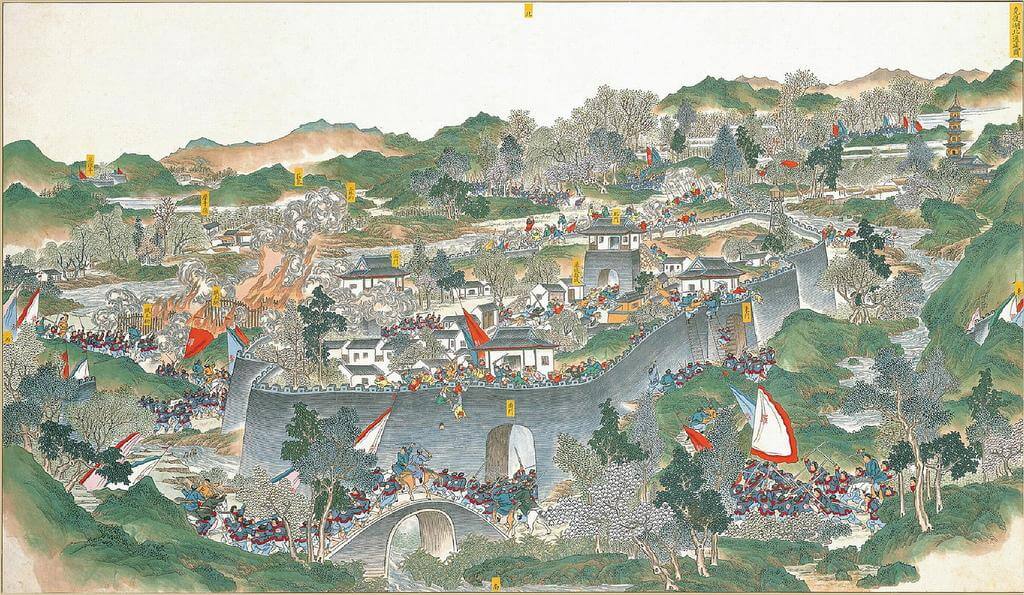 painting of the 1857 Battle of Tongcheng during the Taiping Rebellion
painting of the 1857 Battle of Tongcheng during the Taiping Rebellion
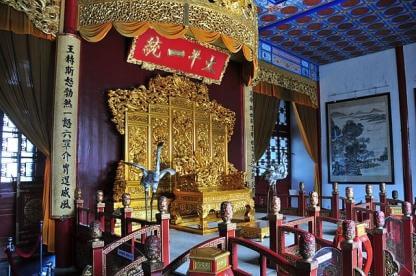 the throne of the Heavenly King Hong Xiuquan at the Nanjing Presidential PalaceUpon reaching Nanjing, Hong Xiuquan and his four subordinate kings established their residences in the former Ming palaces. There, they quickly got used to a life of comfort and luxuries, that included the benefit of having their own harem (whereas segregation of the sexes continued to be maintained among the regular Taiping followers, even of husbands and wives)! These internal changes within the Taiping, from a purely egalitarian movement to one where certain leaders were treated and lived like imperial noblemen, resulted in a slowly rising level of resentment among the ordinary Taiping followers, who had to continue to live austere lifestyles in relative poverty.
the throne of the Heavenly King Hong Xiuquan at the Nanjing Presidential PalaceUpon reaching Nanjing, Hong Xiuquan and his four subordinate kings established their residences in the former Ming palaces. There, they quickly got used to a life of comfort and luxuries, that included the benefit of having their own harem (whereas segregation of the sexes continued to be maintained among the regular Taiping followers, even of husbands and wives)! These internal changes within the Taiping, from a purely egalitarian movement to one where certain leaders were treated and lived like imperial noblemen, resulted in a slowly rising level of resentment among the ordinary Taiping followers, who had to continue to live austere lifestyles in relative poverty.
The Qing government tried to suppress the Taiping rebellion continuously but enjoyed little success at first. The Qing army basically consisted of two different contingents. The Green Standard Army that consisted of ordinary Chinese troops made up the vast majority of their forces. The Banners were the Manchu elite troops (that however incorporated other ethnic groups as well, such as the allied Mongols) that had been of paramount importance for the Manchus when they had initially conquered China.
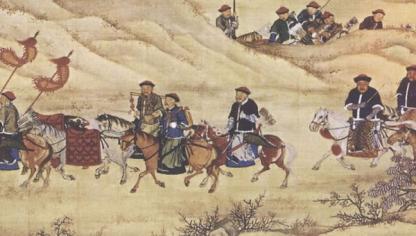 Members of the Manchu Banner troops during a hunting tripBy the 1850s when the Taiping rebellion was under way, both contingents of the Qing army hadn't seen major military action for a long time. The Green Standard Army had last seen extensive military action in the 1670s and 1680s when they had put down Wu Sangui's "Revolt of the Three Feudatories" and even the Manchus' own banner troops hadn't fought in over a century. Soldiers in both armies weren't paid very well (also due to the financial shortfalls in the imperial treasury), which had a negative effect upon their discipline. Insufficient training and military equipment were serious issues as well.
Members of the Manchu Banner troops during a hunting tripBy the 1850s when the Taiping rebellion was under way, both contingents of the Qing army hadn't seen major military action for a long time. The Green Standard Army had last seen extensive military action in the 1670s and 1680s when they had put down Wu Sangui's "Revolt of the Three Feudatories" and even the Manchus' own banner troops hadn't fought in over a century. Soldiers in both armies weren't paid very well (also due to the financial shortfalls in the imperial treasury), which had a negative effect upon their discipline. Insufficient training and military equipment were serious issues as well.
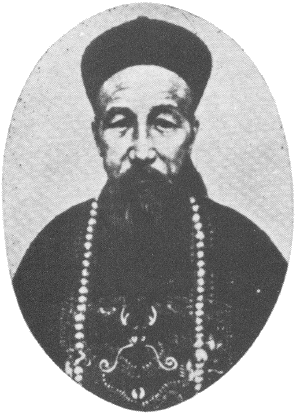 photo of the Qing official Zeng Guofan who raised the Hunan armyThe Qing government eventually became disillusioned with the lack of positive results in the fight of their armies against the Taiping and began to explore new ways to raise a competitive fighting force. Until then, the local literati elites had only been responsible to raise local militias which provided local security (for example by fighting against bandits). Now, the local literati elites were called upon by the Qing government to assume a greater role in the military defence of China.
photo of the Qing official Zeng Guofan who raised the Hunan armyThe Qing government eventually became disillusioned with the lack of positive results in the fight of their armies against the Taiping and began to explore new ways to raise a competitive fighting force. Until then, the local literati elites had only been responsible to raise local militias which provided local security (for example by fighting against bandits). Now, the local literati elites were called upon by the Qing government to assume a greater role in the military defence of China.
Out of the many local leaders that got involved in the raising of regional armies that fought against the Taiping, the official Zeng Guofan (AD 1811 - 1872) became the most famous. He was given the authority by the central Qing government to raise and lead a local army in his native Hunan province that could fight against the Taiping effectively. To finance the costly operation of such an army, he was given control over the local lijin revenues (a kind of tariff on local trade) in Hunan. This new source of revenue was collected in modest amounts at various stations within Hunan province, but amounted to a considerable amount in its totality (also since there was lots of local trade within the rice and tea growing province of Hunan).
Zeng Guofan quickly used these funds to recruit soldiers for his Hunan army, which were then professionally trained and equipped with modern weaponry. In their fighting campaigns against the Taiping army which started in the late 1850s and early 1860s, the Hunan army quickly distinguished itself through their high discipline (which besides their superior training might have been due to the fact that they were much better paid and taken care of then regular Qing army troops).
The Western powers that had established themselves in various treaty ports along the South China coast also made a small but significant contribution in the fight against the Taiping. The most northerly treaty port of Shanghai, which had only been an obscure fishing village when it was opened as a treaty port in AD 1842, had benefited from its advantageous location close to the mouth of the Yangtze River and within a decade become the center of European activity in China.
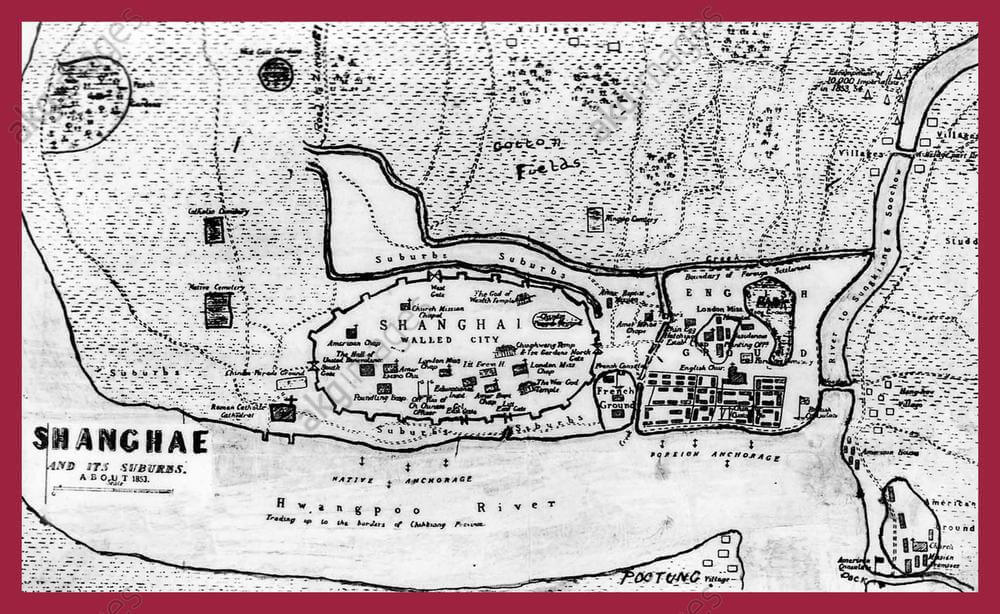 map of Shanghai in 1853
map of Shanghai in 1853
Initially reluctant to take action against the Taiping movement which after all had presented itself as a Christian movement, the Western powers changed their mind after they had followed Hong Xiuquan's invitation and sent a diplomatic delegation to Nanjing to meet the Taiping leadership. As a result of that visit, they came to see the Taiping leaders as unreliable and Hong Xiuquan as a quasi-lunatic and decided that supporting the Qing government served their own interests best. Limited but nevertheless important Western military intervention supporting the Qing government ensued.
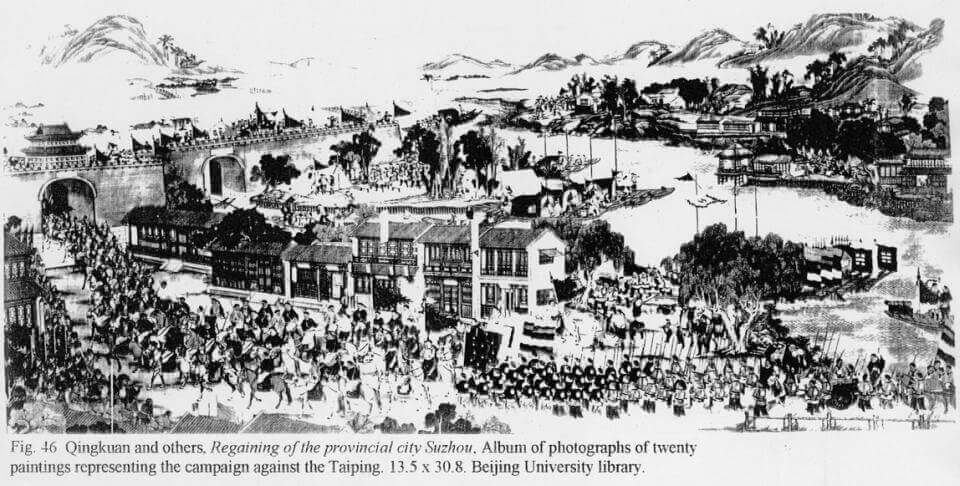 drawing of the retaking of the city of Suzhou near the end of the Taiping Rebellion by the Qing army
drawing of the retaking of the city of Suzhou near the end of the Taiping Rebellion by the Qing army
More than Western intervention, it was the continuing military successes of the Hunan army that were the most instrumental in the defeat of the Taiping Heavenly Kingdom in AD 1864. The rebellion came to a bloody end in great battles and massacres in Nanjing and other localities, that were also due to treachery and internal conflicts within the Taiping leadership. By the end of the Taiping rebellion, the various Western powers had established their position firmly in treaty ports along the South China coast.
While the Qing empire was trying to get the Taiping Rebellion under control, further conflict with the Western powers arose as well. Britain and France began to exert pressure on the Qing government to renegotiate the terms of the Treaty of Nanjing. A renegotiation of that treaty after a period of twelve years had been one of the provisions of that treaty. The demands of the Western powers were targeted towards gaining even more power within China, both politically and economically. One of their demands was the complete legalization of the opium trade! The Qing government understandably rejected these demands.
Chengde Mountain Resort
The Chengde Mountain Resort is located in Hebei province just north of the city center of Chengde. It was built from AD 1703 until 1792 as a summer resort for the imperial family of the Qing dynasty due to Chengde's pleasant climate and appealing natural scenery. Now a UNESCO world heritage site, the resort includes the largest imperial garden in China. The huge total area of the Chengde Mountain Resort is divided into four parts: a Palace Area, Lake Area, Plain Area and Mountain Area.
Click here to learn more!Opening Hours
April - October: 7am - 6pm
November - March: 8am - 5.30pm
Entrance Ticket Prices
April - October: 145 yuan
November - March: 90 yuan
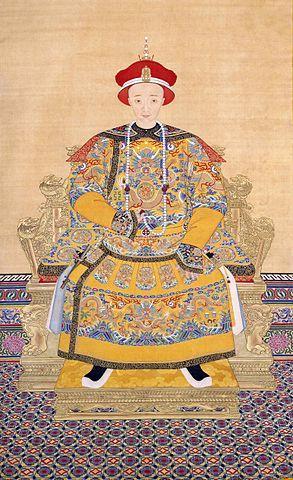 Qing dynasty painting of the Xianfeng EmperorThe Second Opium War followed from AD 1856 to 1860. The triggering incident was the capture of the cargo ship "Arrow" (which sailed with British registration although operated by a Chinese crew) by the Chinese marines in Canton in October 1856. The Qing military, though greatly outnumbering the British and French forces in size, proved to be no match once again to resist the superior fighting ability of the Western alliance.
Qing dynasty painting of the Xianfeng EmperorThe Second Opium War followed from AD 1856 to 1860. The triggering incident was the capture of the cargo ship "Arrow" (which sailed with British registration although operated by a Chinese crew) by the Chinese marines in Canton in October 1856. The Qing military, though greatly outnumbering the British and French forces in size, proved to be no match once again to resist the superior fighting ability of the Western alliance.
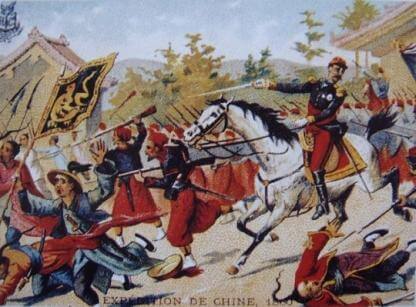 postcard showing an attack of the French forces during the Second Opium War in 1860The humiliation of the Qing empire in the Second Opium War came to be exemplified by the Xianfeng Emperor fleeing Beijing to the Chengde Mountain Resort and the needless destruction and looting of Beijing's Old Summer Palace by the British and French troops.
postcard showing an attack of the French forces during the Second Opium War in 1860The humiliation of the Qing empire in the Second Opium War came to be exemplified by the Xianfeng Emperor fleeing Beijing to the Chengde Mountain Resort and the needless destruction and looting of Beijing's Old Summer Palace by the British and French troops.
The Old Summer Palace and its gardens were once described as the "Versailles of the East" and the "Garden of Gardens". Their wilfull destruction are still a sore point in the relations between China and the West today and the Communist Party of China (CPC) has often used this act as a symbol for China's century of humiliation. Despite the lamentable results of this historic event, it is also important to remember the acts that led up to it.
In fact, the destruction of the Old Summer Palace in October of AD 1860 was ordered by Lord Elgin who was Britain's High Commissioner to China at that time. It came in retaliation for the brutal torture and killing (involving the method of slow slicing which has also come to be known as death by a thousand cuts) of around twenty Western and Indian prisoners (including two British envoys and a journalist for The Times) that were sent to Beijing to negotiate in peace talks. Even the destruction of Beijing's Forbidden City was discussed as a retaliation measure!
The partial and even the complete restoration of the Old Summer Palace has occasionally been discussed in China in modern times. The estimated astronomical costs of such an endeavor are usually cited as the main reason for the rejection of such plans. However, efforts have been undertaken to at least digitally restore the former glory of the Old Summer Palace using modern Virtual Reality technology. There has also been some small-scale reconstruction of certain buildings that once stood on the grounds of the Old Summer Palace such as the Zhenjue Temple.
Old Summer Palace
The Old Summer Palace was a complex of palaces and gardens that the emperors of the Qing dynasty mostly used as a summer resort but later on even as their main imperial residence. Most Chinese people today refer to the entire complex that is located in the northwest of Beijing as Yuanmingyuan. Most buildings that once stood on the grounds of the Old Summer Palace were unfortunately destroyed during tumultuous times in history. The still-existing ruins and gardens are nowadays a part of Yuanmingyuan Park.
Click here to learn more!Opening Hours
May - August: 7am - 7pm
April, September, October: 7am - 6pm
November - March: 7am - 5.30pm
Entrance Ticket Prices
10 yuan
Sites of European Palaces: + 15 yuan
Exhibition Hall: + 10 yuan
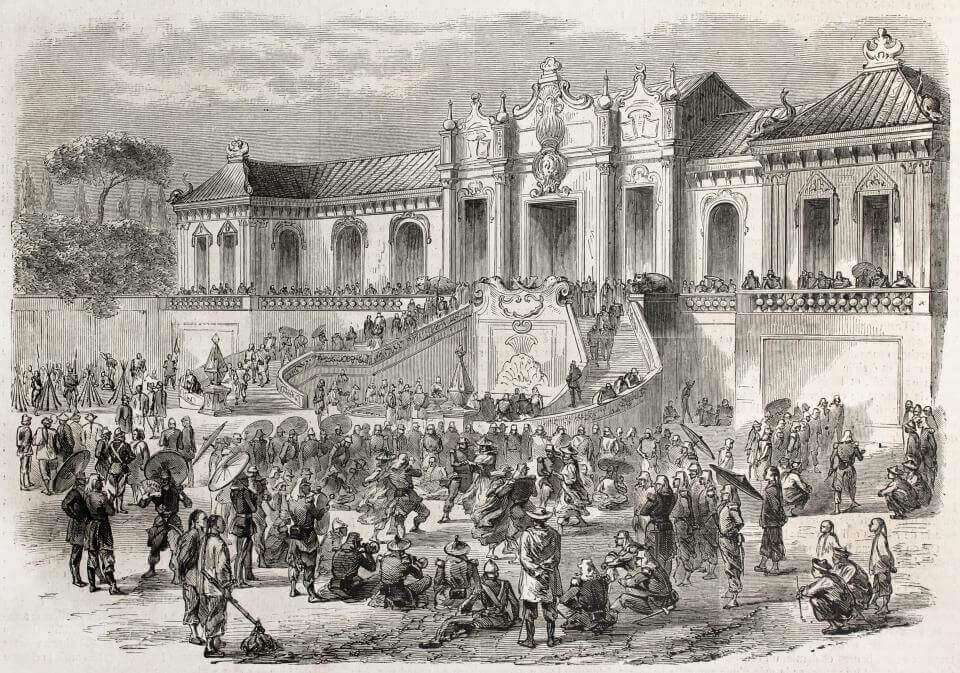 Looting of the Old Summer Palace Yuanmingyuan by Anglo-French forces in AD 1860
Looting of the Old Summer Palace Yuanmingyuan by Anglo-French forces in AD 1860
The new Summer Palace Yiheyuan suffered serious damage as well. Both Yiheyuan as well as the ruins of the Old Summer Palace Yuanmingyuan should be on the itinerary of every foreign visitor to Beijing. The Western powers got what they wanted when China signed the Treaty of Tianjin after the end of the Second Opium War.
new Summer Palace
The new Summer Palace Yiheyuan was another private pleasure resort of palaces, lakes and gardens for the emperors of the Qing dynasty and their families. Later emperors used it as their official residence. Unlike the Old Summer Palace that lies nearby in ruins, most parts of Beijing's new Summer Palace that were damaged or destroyed during the late 19th century were later restored. It is now a UNESCO World Heritage site and one of the most popular tourist attractions in China.
Click here to learn more!Opening Hours
April - October: 6.30am - 6pm
(scenic spots: 8.30am - 5pm)
November - March: 7am - 5pm
(scenic spots: 9am - 4pm)
Entrance Ticket Prices
April - October: 30 - 60* yuan
November - March: 20 - 50* yuan
* price for Combo Ticket
Dehe Garden: + 5 yuan, Tower of Buddhist Incense and Hall of Dispelling Clouds: + 10 yuan, Wenchang Gallery: + 20 yuan, Suzhou Market Street and Danning Hall: + 10 yuan
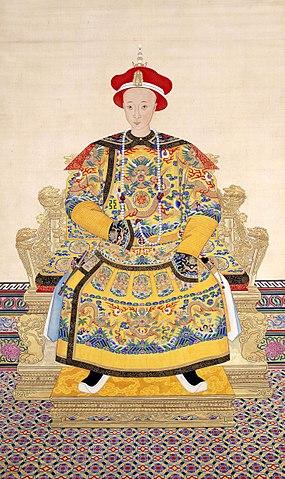 Qing dynasty portrait of the Tongzhi EmperorThe Qing government tried to respond to the perceived threat of a continued Western presence in China by launching a series of reforms, that were meant to restore China to its former glory. Having been forced to sign a series of treaties with Western nations that came to be called the Unequal Treaties within China had been a major humiliation for the Qing government. Between the 1860s and the early 1890s, a sizable group of Chinese and Manchu leaders within the Qing government launched a program that came to be known as the Self-Strengthening Movement. The 1860s proved to be a suitable time to launch such a program, since the child emperor Zaichun (the Tongzhi Emperor) who had ascended the throne in AD 1861 was still guided in his decisions by a council of regents, most of whom clearly perceived the need to find new solutions to address China's growing problems.
Qing dynasty portrait of the Tongzhi EmperorThe Qing government tried to respond to the perceived threat of a continued Western presence in China by launching a series of reforms, that were meant to restore China to its former glory. Having been forced to sign a series of treaties with Western nations that came to be called the Unequal Treaties within China had been a major humiliation for the Qing government. Between the 1860s and the early 1890s, a sizable group of Chinese and Manchu leaders within the Qing government launched a program that came to be known as the Self-Strengthening Movement. The 1860s proved to be a suitable time to launch such a program, since the child emperor Zaichun (the Tongzhi Emperor) who had ascended the throne in AD 1861 was still guided in his decisions by a council of regents, most of whom clearly perceived the need to find new solutions to address China's growing problems.
Zeng Guofan, whose leadership of the Hunan army had been instrumental in ending the Taiping Rebellion, distinguished himself again in this movement alongside other provincial leaders. The self-strengtheners launched a number of initiatives - the core of them in the 1870s and 1880s - that were meant to give China the power to stand up to the Western imperialist powers (and not have to accept any further humiliating treaties).
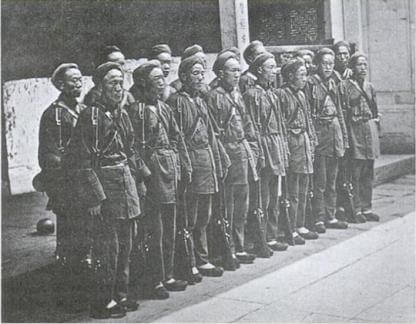 troops of the imperial Qing army around AD 1867 during their training by foreign officersPerhaps the most important part of their initiatives was aimed at improving China's military strength through modernization in order to bring it up to the superior level of the Western armies. China subsequently bought ships and other military equipment from Britain and other Western powers, which made sure to only sell China outdated/obsolete weaponry in order to maintain their own military advantage. After Chinese leaders began to realize that the Western powers would never help them to really catch up militarily, they shifted their focus to rely on their own resources more and more. China subsequently established a modern arsenal in the central Chinese city of Hanyang (nowadays part of the metropolis of Wuhan) on the Yangtze River.
troops of the imperial Qing army around AD 1867 during their training by foreign officersPerhaps the most important part of their initiatives was aimed at improving China's military strength through modernization in order to bring it up to the superior level of the Western armies. China subsequently bought ships and other military equipment from Britain and other Western powers, which made sure to only sell China outdated/obsolete weaponry in order to maintain their own military advantage. After Chinese leaders began to realize that the Western powers would never help them to really catch up militarily, they shifted their focus to rely on their own resources more and more. China subsequently established a modern arsenal in the central Chinese city of Hanyang (nowadays part of the metropolis of Wuhan) on the Yangtze River.
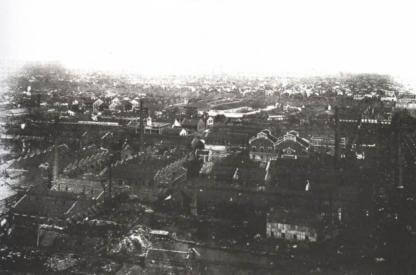 photo of the Hanyang Arsenal in Hubei provinceBenefiting from its proximity to major coal and iron ore resources, the area that is now Wuhan quickly became a center of China's emerging steel industry. This industry quickly grew beyond its original purpose of supplying steel for China's military needs. Furthermore, a great shipyard was built near the mouth of the Yangtze River with the goal of catching up to the military strength of the superior Western fleets.
photo of the Hanyang Arsenal in Hubei provinceBenefiting from its proximity to major coal and iron ore resources, the area that is now Wuhan quickly became a center of China's emerging steel industry. This industry quickly grew beyond its original purpose of supplying steel for China's military needs. Furthermore, a great shipyard was built near the mouth of the Yangtze River with the goal of catching up to the military strength of the superior Western fleets.
Realizing that the Western superiority was not based on military strength alone, the self-strengtheners also launched a series of efforts to help China learn from Western science and technology. The Qing government set up a special bureau for translating Western books which were then published in Chinese and circulated among the educated literati elite. Practical books about science and technology were translated first, but books about social science and political theory were translated later as well. The theory of Social Darwinism (which saw the competition among nations as an example for the survival of the fittest) enjoyed special popularity among the self-strengtheners during this later period.
The third goal of the Self-Strengthening Movement was the restructuring of the way China maintained foreign relations. For centuries if not longer, China had seen itself as the center of the world. In the past, foreign delegations had visited China's imperial capital in order to pay tribute, for which the emperor had rewarded them with great gifts that they took back to their homelands. The idea of treaties between countries was a new and intriguing one for China, since it basically meant that diplomatic relations between nations were based on equality (as with all contracts), even though the content of the treaties that China had been forced to sign by the domineering Western countries was unequal. After the reform of the self-strengtheners, China's international relations including all diplomatic interaction with Western powers were henceforth handled by a new governmental institution - the Zongli Yamen - which can be compared to a foreign ministry in our modern times.
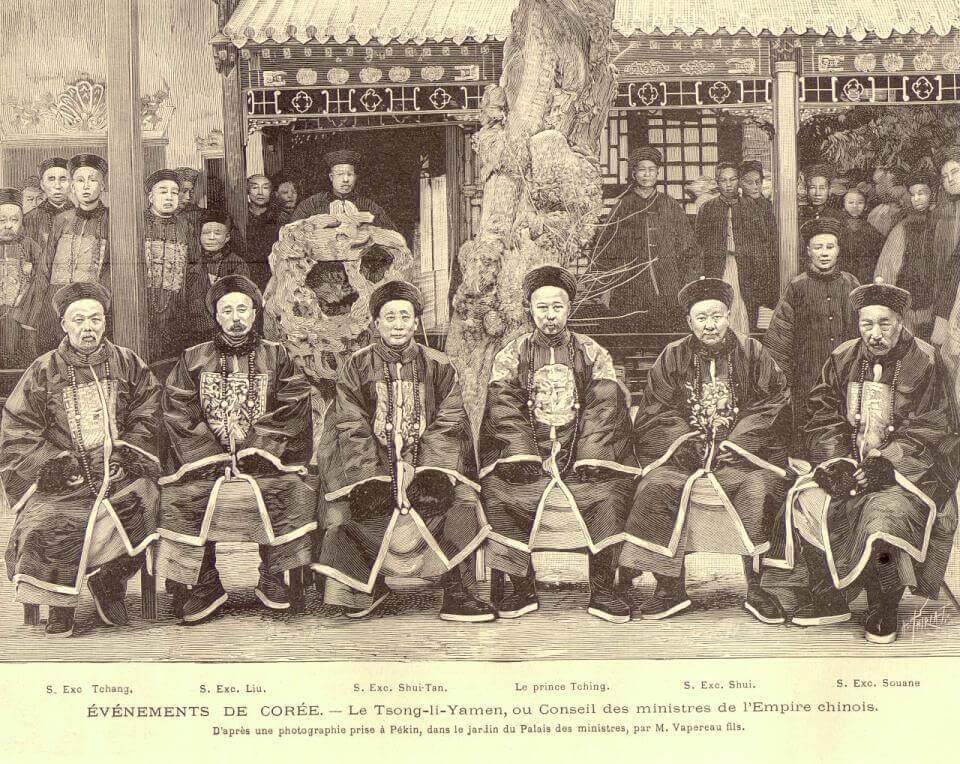 photo of the members of the Zongli Yamen in AD 1894 at the time of the First Sino-Japanese War
photo of the members of the Zongli Yamen in AD 1894 at the time of the First Sino-Japanese War
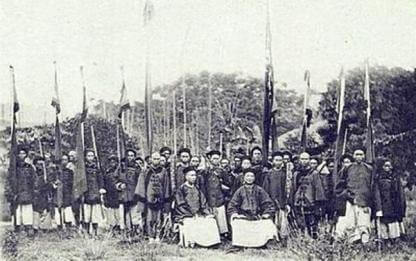 photo of Qing army soldiers during the Sino-French WarAltogether, the reforms of the self-strengtheners were insufficient to overcome the tremendous obstacles that China was facing. Further reforms to modernize China would have been necessary, but were difficult to put in place since the Self-Strengthening Movement (though led by highly-respected and successful individuals) never constituted a majority in Chinese political circles. The majority of the educated Chinese elite remained conservative in their political orientation and undermined and even outright resisted efforts to change the "old ways", the traditional Confucian ways in which things had always been done.
photo of Qing army soldiers during the Sino-French WarAltogether, the reforms of the self-strengtheners were insufficient to overcome the tremendous obstacles that China was facing. Further reforms to modernize China would have been necessary, but were difficult to put in place since the Self-Strengthening Movement (though led by highly-respected and successful individuals) never constituted a majority in Chinese political circles. The majority of the educated Chinese elite remained conservative in their political orientation and undermined and even outright resisted efforts to change the "old ways", the traditional Confucian ways in which things had always been done.
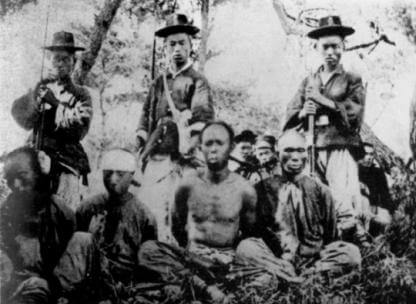 Korean soldiers and Chinese captives during the First Sino-Japanese WarThe insufficiency of all efforts to modernize the Chinese military became apparent in a troubling way in the 1880s. The government of Vietnam, a long-time Chinese ally in Southeast Asia, had appealed to the Qing government to provide military assistance in their war against France. The contingent of the Chinese modernized navy that was subsequently sent to aid the Vietnamese was no match for the modern and experienced French navy. That was a further humiliating blow to the Chinese ego and allowed France to maintain its dominating control over Indochina.
Korean soldiers and Chinese captives during the First Sino-Japanese WarThe insufficiency of all efforts to modernize the Chinese military became apparent in a troubling way in the 1880s. The government of Vietnam, a long-time Chinese ally in Southeast Asia, had appealed to the Qing government to provide military assistance in their war against France. The contingent of the Chinese modernized navy that was subsequently sent to aid the Vietnamese was no match for the modern and experienced French navy. That was a further humiliating blow to the Chinese ego and allowed France to maintain its dominating control over Indochina.
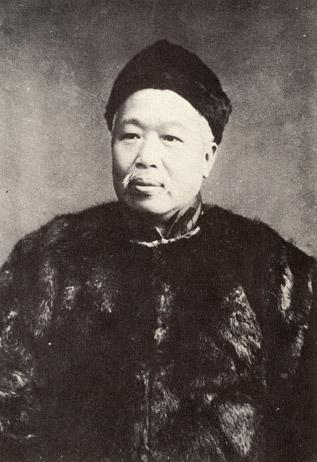 photo of the minor Qing official Kang YouweiTen years later, the First Sino-Japanese War that was primarily fought on the Korean peninsula from AD 1894 - 1895 over the control of Korea ended in an even more humiliating way for China. Japan had thoroughly modernized all aspects of their economy under the Meiji Restoration (that had started in AD 1868) and was no longer China's little brother as which it was still seen in the minds of many Chinese. The modernized Japanese army destroyed much of China's supposedly modern fleet and also defeated the Chinese army on land again and again in humiliating fashion. China had to sign another humiliating treaty on the 17th of April 1895 - the Treaty of Shimonoseki - which triggered a protest movement in China.
photo of the minor Qing official Kang YouweiTen years later, the First Sino-Japanese War that was primarily fought on the Korean peninsula from AD 1894 - 1895 over the control of Korea ended in an even more humiliating way for China. Japan had thoroughly modernized all aspects of their economy under the Meiji Restoration (that had started in AD 1868) and was no longer China's little brother as which it was still seen in the minds of many Chinese. The modernized Japanese army destroyed much of China's supposedly modern fleet and also defeated the Chinese army on land again and again in humiliating fashion. China had to sign another humiliating treaty on the 17th of April 1895 - the Treaty of Shimonoseki - which triggered a protest movement in China.
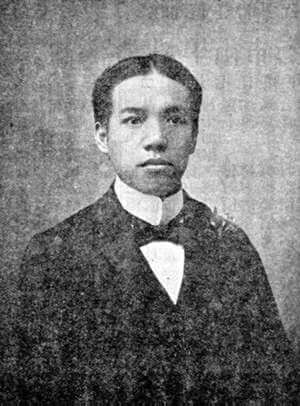 photo of the minor Qing official Liang QichaoCandidates that had assembled to take the highest level of the imperial examinations in Beijing circulated a petition that demanded from the Qing government to find a more effective response to imperialist aggression. It received several thousand signatures before it was submitted to the imperial court. The two minor officials Kang Youwei (AD 1858 - 1927) and Liang Qichao (AD 1873 - 1929) became the most prominent leaders of this movement in which many officials from all over China got involved.
photo of the minor Qing official Liang QichaoCandidates that had assembled to take the highest level of the imperial examinations in Beijing circulated a petition that demanded from the Qing government to find a more effective response to imperialist aggression. It received several thousand signatures before it was submitted to the imperial court. The two minor officials Kang Youwei (AD 1858 - 1927) and Liang Qichao (AD 1873 - 1929) became the most prominent leaders of this movement in which many officials from all over China got involved.
Working closely together, they began to write articles and published newspapers. Using their right as officials, they submitted memorials to the throne in which they argued in favour of adopting a more ambitious reform program with the goal of making all aspects of governmental administration more effective through a complete institutional restructuring.
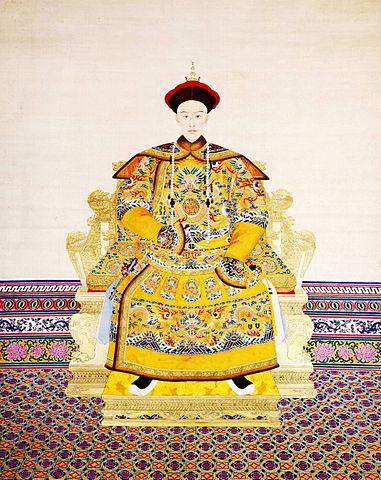 Qing dynasty painting of the Guangxu EmperorTheir agitation efforts began to bear fruit in mid-1898, when the Guangxu Emperor (AD 1871 - 1908) initiated a fairly radical reform project that was based upon the ideas of the reformers. The Guangxu Emperor had ascended the throne two decades earlier in AD 1875 when he was still a child. During the early years of his reign, it had been Empress Dowager Cixi (AD 1835 - 1908) who had held the de-facto power. After Cixi had sort of retired from directly overseeing the daily court proceedings around AD 1890, the Guangxu Emperor took the initiative to manage the affairs of state more and more into his own hands.
Qing dynasty painting of the Guangxu EmperorTheir agitation efforts began to bear fruit in mid-1898, when the Guangxu Emperor (AD 1871 - 1908) initiated a fairly radical reform project that was based upon the ideas of the reformers. The Guangxu Emperor had ascended the throne two decades earlier in AD 1875 when he was still a child. During the early years of his reign, it had been Empress Dowager Cixi (AD 1835 - 1908) who had held the de-facto power. After Cixi had sort of retired from directly overseeing the daily court proceedings around AD 1890, the Guangxu Emperor took the initiative to manage the affairs of state more and more into his own hands.
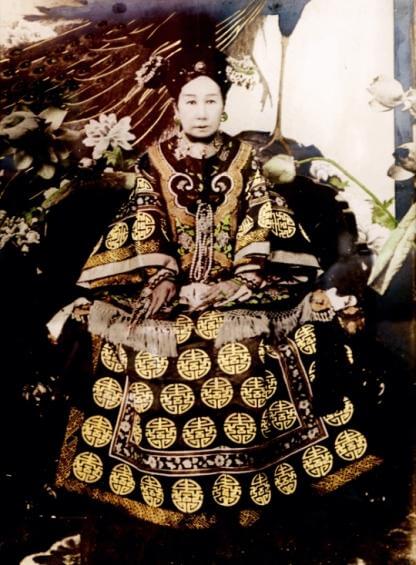 photo of Empress Dowager CixiStarting in the middle of June 1898, the Guangxu Emperor issued a series of edicts that were meant to streamline the imperial administration and bureaucracy in an effort to make them more effective and efficient. He also tried to create new channels of communication that ordinary citizens could use to get in touch with their government in order to make useful suggestions for the improvement of certain policies. Furthermore, many reform advocates were appointed to high positions within the Qing government, including to the highest consultative body - the Grand Council.
photo of Empress Dowager CixiStarting in the middle of June 1898, the Guangxu Emperor issued a series of edicts that were meant to streamline the imperial administration and bureaucracy in an effort to make them more effective and efficient. He also tried to create new channels of communication that ordinary citizens could use to get in touch with their government in order to make useful suggestions for the improvement of certain policies. Furthermore, many reform advocates were appointed to high positions within the Qing government, including to the highest consultative body - the Grand Council.
Such a dramatic reform project had of course many opponents within the government as well. Some of them simply ignored the reform plans in an act of passive disobedience, others resisted these efforts outright and refused to implement the reform measures. By mid-September 1898, the conservative majority within the Chinese and Manchu leadership had enough of these far-reaching reform projects that came to be known as the Hundred Days' Reforms.
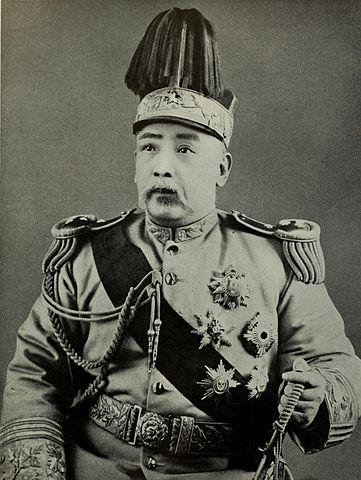 photo of the President of the Republic of China Yuan Shikai in AD 1915Yuan Shikai (AD 1859 - 1916), the military commander of the modernized part of the Chinese army, conspired with Empress Dowager Cixi to have the Guangxi Emperor placed under house arrest. The subsequent arrest of many leading reformers (out of which eight were executed) brought the Hundred Days' Reforms to a final and bloody end. Kang Youwei and Liang Qichao however managed to flee Beijing in time after being tipped off and eventually made their way to Japan through the treaty port of Shanghai. The Hundred Days' Reforms were perhaps the last chance for the traditionally conservative Qing government to embark on a necessary course of modernization.
photo of the President of the Republic of China Yuan Shikai in AD 1915Yuan Shikai (AD 1859 - 1916), the military commander of the modernized part of the Chinese army, conspired with Empress Dowager Cixi to have the Guangxi Emperor placed under house arrest. The subsequent arrest of many leading reformers (out of which eight were executed) brought the Hundred Days' Reforms to a final and bloody end. Kang Youwei and Liang Qichao however managed to flee Beijing in time after being tipped off and eventually made their way to Japan through the treaty port of Shanghai. The Hundred Days' Reforms were perhaps the last chance for the traditionally conservative Qing government to embark on a necessary course of modernization.
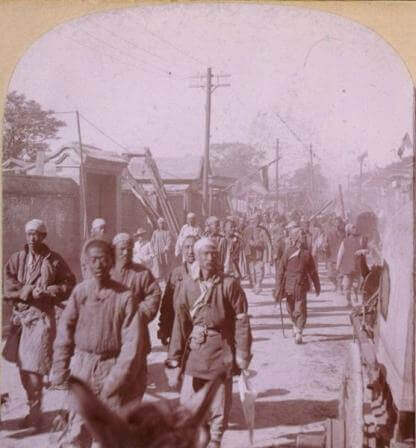 Group of Boxers walking down the street in Tien-Tsin (now called Tianjing)Meanwhile in the east of China, a movement of martial-arts practitioners that called themselves the Boxers increased its popularity rapidly and started to spread across the region from its center in the western part of Shandong province.
Group of Boxers walking down the street in Tien-Tsin (now called Tianjing)Meanwhile in the east of China, a movement of martial-arts practitioners that called themselves the Boxers increased its popularity rapidly and started to spread across the region from its center in the western part of Shandong province.
The Boxers irrationally believed that they could achieve supernatural powers and invulnerability from physical harm (including from bullets!) through the ritual practice of certain physical and spiritual exercises. Many similar peasant movements that often had religious and/or spiritual or even mythical undertones had arisen in the history of China before and the relative poor areas of Shandong had been a particular hotbed for the germination of such ideas in the 19th century.
The Boxer's wrath was mainly directed against the strong foreign presence in this part of China. The Germans had acquired concessions in the eastern part of Shandong province in AD 1898 and were mainly based in the coastal port of Qingdao (then called Tsingtau). German activity extended beyond Qingdao however and especially German Christian missionaries (who were protected in their activity by the Qing government under the terms of the signed treaties) were very active in the western interior of Shandong province.
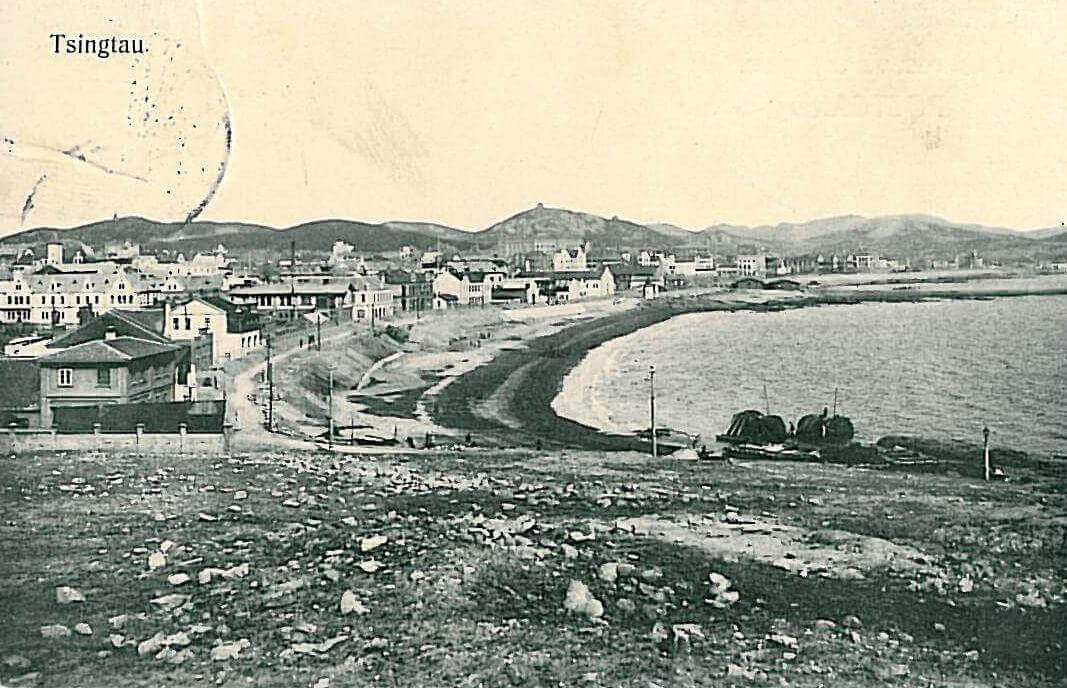 historical postcard of Tsingtau (ca. AD 1909)
historical postcard of Tsingtau (ca. AD 1909)
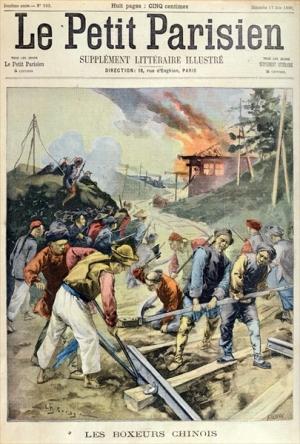 front page of the French newspaper "Le Petit Parisien" showing Chinese Boxers destroying a railroad during the Boxer RebellionMany Chinese locals were opposed to this strong alien presence within their territories and their resentment also grew as a result of the dishonest ways in which some of their Chinese compatriots came to adopt the Christian religion for themselves.
front page of the French newspaper "Le Petit Parisien" showing Chinese Boxers destroying a railroad during the Boxer RebellionMany Chinese locals were opposed to this strong alien presence within their territories and their resentment also grew as a result of the dishonest ways in which some of their Chinese compatriots came to adopt the Christian religion for themselves.
Many Chinese converts, disparagingly called "Rice Christians" by the locals, used the conversion efforts of the German missionaries to gain material benefits for themselves. Converted Christians had much easier access to food and charity and some of them even used their affiliation with the German missionaries to gain advantages in lawsuits and other local disputes.
Understandably, that behaviour fueled the resentment among the local population against their dishonest opportunist neighbours, the German missionaries and even the Qing government that protected them under the terms of the treaty.
After the end of the Hundred Days' Reforms, the Qing government became more encouraging of movements like the Boxers, which the Chinese governor of Shandong province even lauded for their patriotic spirit in a series of official proclamations. Due to that official encouragement, the Boxers began to increase their activities and became more aggressive in their efforts to "purify" China from foreign "barbarian" domination and control.
The number of their followers increased exponentially and in the winter of 1899/1900, the Boxers moved north and out of Shandong province towards the treaty port of Tianjin (southeast of Beijing), which officially launched the Boxer Rebellion.
Their march continued in the summer of 1900, this time directly to the imperial capital of Beijing where they were well received by the local population and not impeded in their activities by the imperial army. In fact, Empress Dowager Cixi (who firmly controlled the Qing government at that time) proclaimed that she was on the side of the Boxers.
Thereafter, the Boxers began to harass Westerners that they encountered in Beijing and in June of 1900, they laid Beijing's Legation Quarter (where foreign countries had established their diplomatic missions) under siege for 55 days.
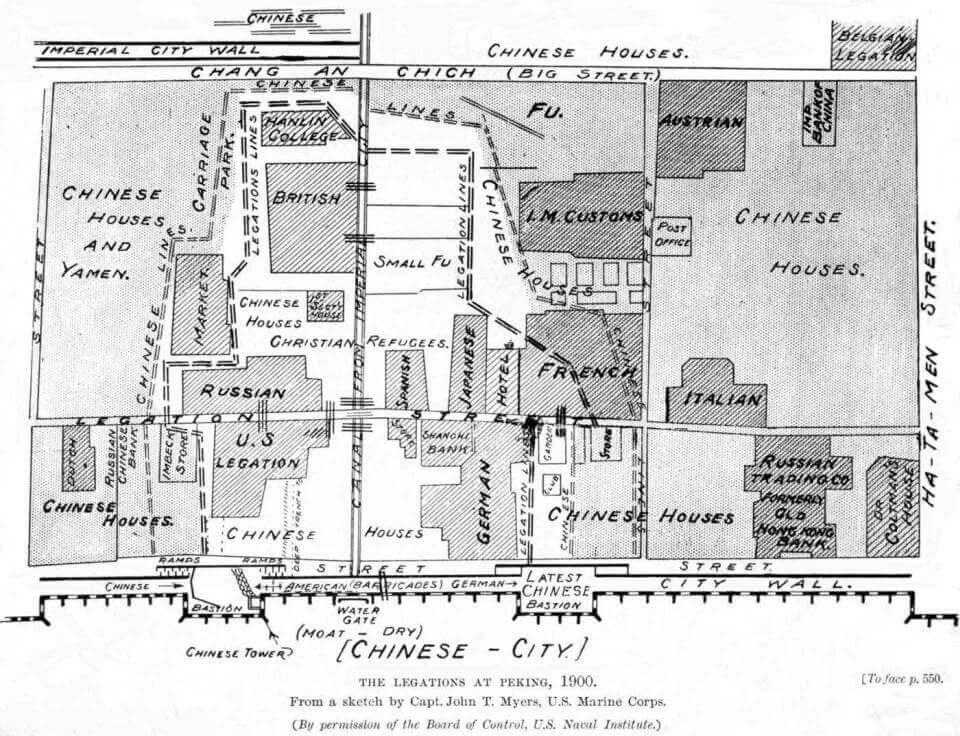 locations of foreign diplomatic legations in the Beijing Legation Quarter during the Boxer siege of AD 1900
locations of foreign diplomatic legations in the Beijing Legation Quarter during the Boxer siege of AD 1900
This siege was only lifted when an international military force of eight countries came to the rescue and defeated the Boxers by the middle of August, after having to fight their way in a time-consuming fashion from Tianjin to the capital along the railway line. The Eight-Nation Alliance of Western powers then occupied Beijing, from which Empress Dowager Cixi and the Guangxu Emperor had already fled towards Xi'an (where they found shelter at the Huaqing Hot Springs).
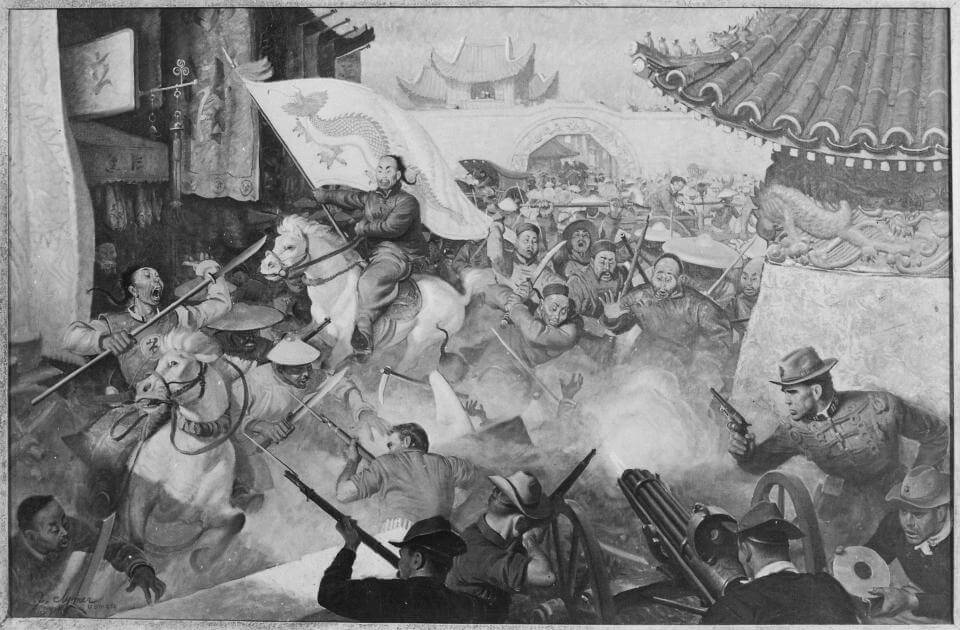 US Marines fight rebellious Boxers outside the Beijing Legation Quarter in AD 1900
US Marines fight rebellious Boxers outside the Beijing Legation Quarter in AD 1900
This further humiliation for China was completed with another treaty, the Boxer Protocol, that forced China to pay a huge indemnity of 450 million taels of silver to the Western powers. This monetary indemnity was directly drawn from China's maritime customs receipts (whose collection was administered by foreign officials!) and was a huge financial blow for the Qing government.
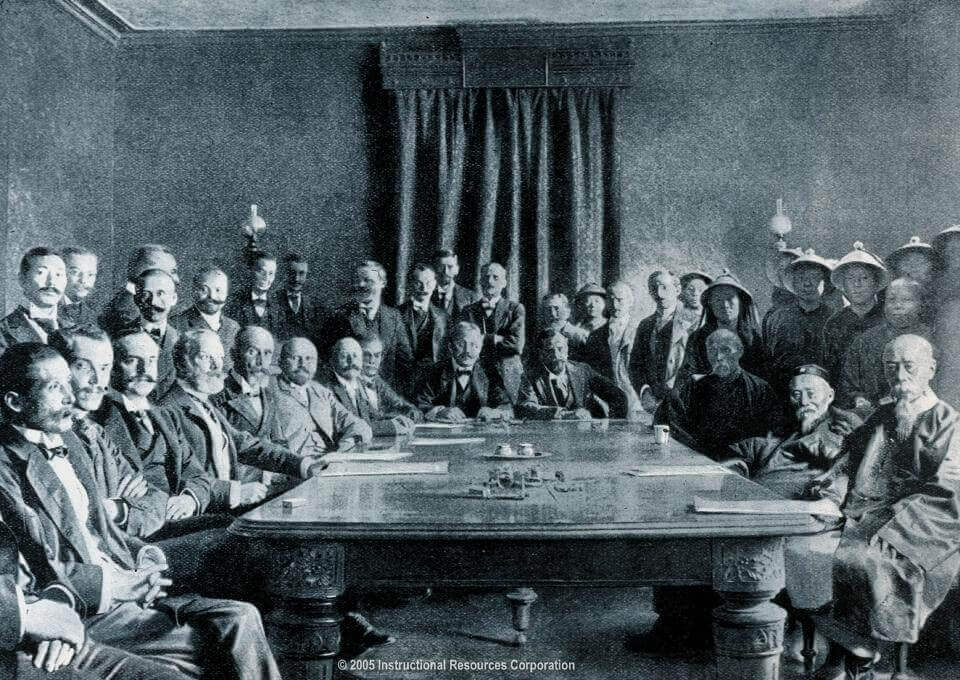 Signing of the Boxer Protocol. From left to right: F.M Knobel from the Netherlands (only his hands are visible); K. Jutaro from Japan; G. S. Raggi from Italy; Joostens from Belgium; C. von Walhborn from Austria-Hungary; B. J. Cologán from Spain; M. von Giers from Russia; A. Mumm from the German Empire; E. M. Satow from the United Kingdom; W. W. Rockhill from the US; P. Beau from France; I-Kuang; Li Hongzhang; Prince Qing
Signing of the Boxer Protocol. From left to right: F.M Knobel from the Netherlands (only his hands are visible); K. Jutaro from Japan; G. S. Raggi from Italy; Joostens from Belgium; C. von Walhborn from Austria-Hungary; B. J. Cologán from Spain; M. von Giers from Russia; A. Mumm from the German Empire; E. M. Satow from the United Kingdom; W. W. Rockhill from the US; P. Beau from France; I-Kuang; Li Hongzhang; Prince Qing
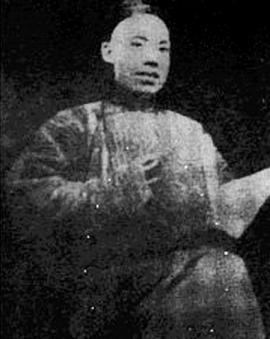 Yang Shenxiu, a politician during the late Qing Dynasty, who played an important role in the Hundred Days' ReformIn the aftermath of the Boxer Rebellion, a number of Qing government officials that had supported the Boxers were executed. Apart from that, the Qing government was allowed to resume its activities after Cixi and the Guangxu Emperor had returned from their hideout. The end of this episode of Chinese history signalled that the days of the Qing dynasty were ultimately numbered. In fact, new alternative ideas regarding the future of China were already beginning to emerge.
Yang Shenxiu, a politician during the late Qing Dynasty, who played an important role in the Hundred Days' ReformIn the aftermath of the Boxer Rebellion, a number of Qing government officials that had supported the Boxers were executed. Apart from that, the Qing government was allowed to resume its activities after Cixi and the Guangxu Emperor had returned from their hideout. The end of this episode of Chinese history signalled that the days of the Qing dynasty were ultimately numbered. In fact, new alternative ideas regarding the future of China were already beginning to emerge.
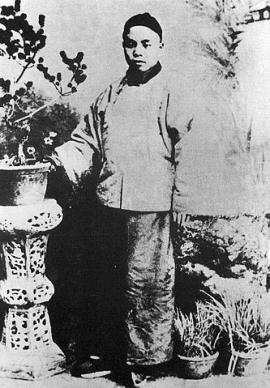 Lin Xu, a Chinese politician during the late Qing Dynasty, one of the "Six Gentlemen" executed by Empress Dowager Cixi after the Hundred Days' ReformAfter the Boxer Rebellion was put to an end and China was humiliated once again by having to sign a treaty that awarded huge indemnities to the Western nations, even the conservative elements within the ruling Qing government and elite circles of society began to see the urgent need for change if China was to remain a strong and independent nation under a dynastic system of leadership. After the withdrawal of the foreign troops of the Eight-Nation Alliance from the capital in 1901, many reforms were set in motion. That included reforms that had already been started and then stopped in 1898 under the Hundred Days' Reform. They were put in place again and further reforms were added, including some reforms that would have been completely unthinkable earlier.
Lin Xu, a Chinese politician during the late Qing Dynasty, one of the "Six Gentlemen" executed by Empress Dowager Cixi after the Hundred Days' ReformAfter the Boxer Rebellion was put to an end and China was humiliated once again by having to sign a treaty that awarded huge indemnities to the Western nations, even the conservative elements within the ruling Qing government and elite circles of society began to see the urgent need for change if China was to remain a strong and independent nation under a dynastic system of leadership. After the withdrawal of the foreign troops of the Eight-Nation Alliance from the capital in 1901, many reforms were set in motion. That included reforms that had already been started and then stopped in 1898 under the Hundred Days' Reform. They were put in place again and further reforms were added, including some reforms that would have been completely unthinkable earlier.
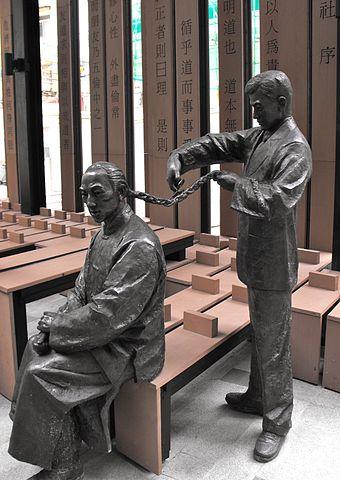 Sculpture "Cutting off the Queue" in Hong Kong's Pak Tsz Lane Park. Cutting off the Manchu queue became an act of protest against Qing rule that was however punishable by death if caught by the authoritiesThe most remarkable change was certainly the abolition of the imperial examination system in 1905. That reform brought an end to an institution that had defined Chinese politics, culture and education since its inception about 2000 years earlier and that had been operating almost without interruptions since AD 1380.
Sculpture "Cutting off the Queue" in Hong Kong's Pak Tsz Lane Park. Cutting off the Manchu queue became an act of protest against Qing rule that was however punishable by death if caught by the authoritiesThe most remarkable change was certainly the abolition of the imperial examination system in 1905. That reform brought an end to an institution that had defined Chinese politics, culture and education since its inception about 2000 years earlier and that had been operating almost without interruptions since AD 1380.
Plans were made to change China's political system from an absolute to a constitutional monarchy. Institutions for political participation and consultation in the cities and treaty ports as well as in the countryside were planned. Provincial assemblies were supposed to be ready to function by 1916.
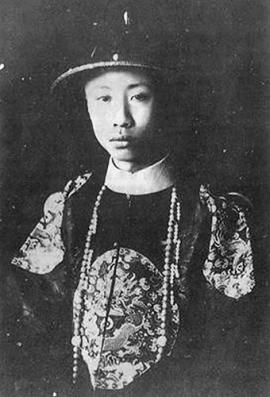 photo showing Puyi, the last Qing emperor, in his youthThough many of these planned reforms were potentially groundbreaking in their scope, many members of the educated elite at that time already saw the imperial system as no longer viable to rule China and favoured Western political systems (like that of a republic). Furthermore, anti-Manchu sentiments had begun to stir again, especially after the story of the siege and subsequent massacre at the city of Yangzhou had begun to circulate in print among the educated elite in the 1890s. Chinese nationalism and patriotism was on the rise and the Manchu-led Qing dynasty was increasingly seen as an alien regime that was out of touch with the harsh realities of life in China under Western imperialist control and domination.
photo showing Puyi, the last Qing emperor, in his youthThough many of these planned reforms were potentially groundbreaking in their scope, many members of the educated elite at that time already saw the imperial system as no longer viable to rule China and favoured Western political systems (like that of a republic). Furthermore, anti-Manchu sentiments had begun to stir again, especially after the story of the siege and subsequent massacre at the city of Yangzhou had begun to circulate in print among the educated elite in the 1890s. Chinese nationalism and patriotism was on the rise and the Manchu-led Qing dynasty was increasingly seen as an alien regime that was out of touch with the harsh realities of life in China under Western imperialist control and domination.
The ambitious reforms that were started in 1901 stalled quite quickly after Empress Dowager Cixi (who had presided over the reform program) and the Guangxu Emperor died within a few hours of each other on the 14th and 15th of November 1908. The young boy Puyi (AD 1905 - 1967) was subsequently placed on the throne as the new emperor of China. The Qing empire was from then on ruled by a council of regents that was made up of Puyi's conservative uncles. The regents effectively slowed down the reform efforts so that only the imperial Qing army continued along a fairly modest path of modernization.
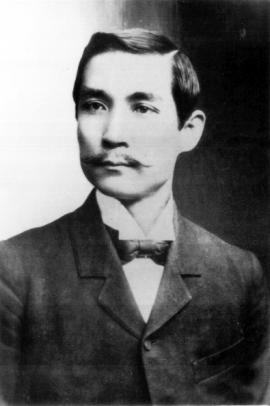 photo of Dr. Sun Yat-sen in August 1900The eventual collapse of the Qing dynasty in 1911/12 is closely connected with the story of two famous individuals, Yuan Shikai and Dr. Sun Yat-sen (AD 1866 - 1925). Born in Guangdong province, Dr. Sun Yat-sen was educated in both Hong Kong and Hawaii (back then still an independent kingdom). In both of these places, he was exposed to modern Western ideas which convinced him that abolishing China's imperial system and replacing it with a Western-style republic was the appropriate course of action in order to restore China to its former strong position in the world.
photo of Dr. Sun Yat-sen in August 1900The eventual collapse of the Qing dynasty in 1911/12 is closely connected with the story of two famous individuals, Yuan Shikai and Dr. Sun Yat-sen (AD 1866 - 1925). Born in Guangdong province, Dr. Sun Yat-sen was educated in both Hong Kong and Hawaii (back then still an independent kingdom). In both of these places, he was exposed to modern Western ideas which convinced him that abolishing China's imperial system and replacing it with a Western-style republic was the appropriate course of action in order to restore China to its former strong position in the world.
His ideas, which had germinated in the 1880s, spurned him on to try to build a political revolutionary movement in the 1890s. These efforts culminated in the first decade of the 20th century with the founding of the Tongmenghui - the Revolutionary League. That was a sort of umbrella organisation that brought together anti-Qing groups with a wide range of political ideas.
Dr. Sun Yat-sen began to travel extensively all around the world in his political agitation and fund-raising efforts for a new Chinese republic. Especially his speeches in front of oversees Chinese communities raised a substantial amount of funds for his efforts at starting a revolution.
However, his revolutionary ideas didn't only gain traction among oversees Chinese but also among the educated elite of the mainland itself, especially after the humiliations of the Sino-Japanese War, failed Hundred Days' Reforms and Boxer Rebellion. Even though Dr. Sun Yat-sen's revolutionary nationalist movement was primarily a political movement, it nevertheless tried to actively start a revolution by organizing local military uprisings (in various parts of China but especially in the deep south) against local Qing powerholders. All these direct military efforts failed however.
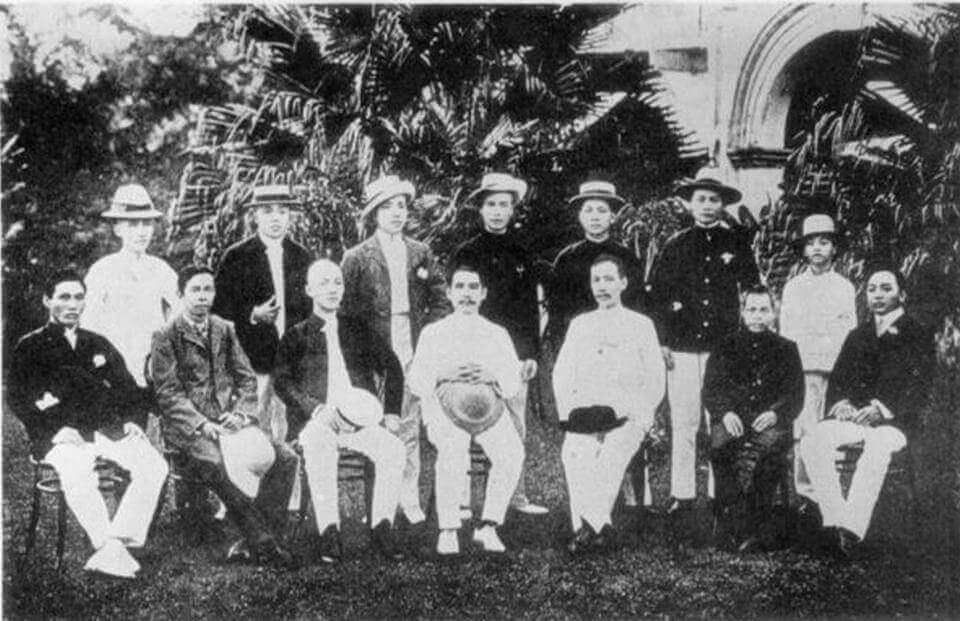 Dr. Sun Yat-sen together with the members of the Singapore Branch of the Tongmenghui. front row from left: Lin Ganting, Zhang Yongfu, Chen Chunan, Sun Yat-sen, You Lie, Liou Jinsheng, Lin Yishun; back row from left: Wu Wusou, Zhang Huadan, Zhang Ji, Chen Ruhe, Deng Ziyu, Huang Yaoting, Zhang Binggeng
Dr. Sun Yat-sen together with the members of the Singapore Branch of the Tongmenghui. front row from left: Lin Ganting, Zhang Yongfu, Chen Chunan, Sun Yat-sen, You Lie, Liou Jinsheng, Lin Yishun; back row from left: Wu Wusou, Zhang Huadan, Zhang Ji, Chen Ruhe, Deng Ziyu, Huang Yaoting, Zhang Binggeng
Dr. Sun Yat-sen is nowadays seen as the father of modern China by Chinese communists and nationalists in Taiwan alike. However, the second major figure in the events of 1911/12 - Yuan Shikai - has a rather sinister reputation today. Already earlier in history, he had been one of the powerful officials within the Qing government who had conspired with Empress Dowager Cixi and put down the Hundred Days' Reforms in 1898. In 1911 when a revolution broke out in parts of China, he positioned himself as a kind of broker between the revolutionary forces and the Qing government in Beijing.
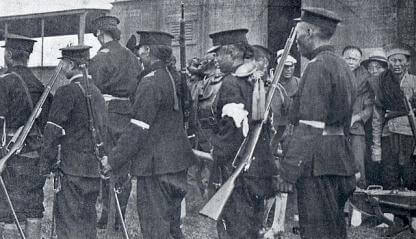 photo showing revolutionary soldiers in WuchangThe exact circumstances of the revolution and later overthrow of the Qing regime were kind of peculiar. Everything started more or less by accident in the central Chinese city of Wuchang (nowadays part of Wuhan). Wuchang was one of the Chinese cities where units of the modernized Chinese military were based. These modern units of the army had become a battleground for different political ideas. That was especially the case among the army's junior officers, since they were usually well-educated and their exposure to Western ideas at a young age had made some of them develop radically progressive ideas of their own. Dr. Sun Yat-sen's Revolutionary League had been very active in its agitation efforts within the junior officer corps of the army.
photo showing revolutionary soldiers in WuchangThe exact circumstances of the revolution and later overthrow of the Qing regime were kind of peculiar. Everything started more or less by accident in the central Chinese city of Wuchang (nowadays part of Wuhan). Wuchang was one of the Chinese cities where units of the modernized Chinese military were based. These modern units of the army had become a battleground for different political ideas. That was especially the case among the army's junior officers, since they were usually well-educated and their exposure to Western ideas at a young age had made some of them develop radically progressive ideas of their own. Dr. Sun Yat-sen's Revolutionary League had been very active in its agitation efforts within the junior officer corps of the army.
Many junior officers were members of the Revolutionary League and some of them were actively involved in the conspiratorial planning of various kinds of insurrections. One of these conspiratorial groups was secretly plotting a series of bombings in the city of Hankou (another part of modern Wuhan) that were meant to trigger a popular uprising. Their activities were discovered in October 1911 when one of their bombs accidentally exploded in a part of the city that was a Russian economic concession.
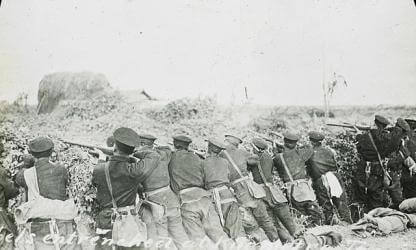 photo of rebel soldiers firing at imperial Qing troops during the Wuchang Uprising in AD 1911That raised the suspicion of the local authorities who began their preparations to arrest some of the known and suspected political leaders within the military. As a preemptive move, the young radical junior officers launched an uprising in Wuchang during which they had the senior military officers and local Qing magistrates arrested. Thereafter, the leaders of the uprising called upon the military and local population to support them in a rebellion against the Qing dynasty and proclaimed the founding of the Republic of China, led by the temporary military government of Hubei. During the following weeks, other military units in other provinces followed suit (particularly in Central China but later also in other areas) and proclaimed their independence from the Qing empire as well.
photo of rebel soldiers firing at imperial Qing troops during the Wuchang Uprising in AD 1911That raised the suspicion of the local authorities who began their preparations to arrest some of the known and suspected political leaders within the military. As a preemptive move, the young radical junior officers launched an uprising in Wuchang during which they had the senior military officers and local Qing magistrates arrested. Thereafter, the leaders of the uprising called upon the military and local population to support them in a rebellion against the Qing dynasty and proclaimed the founding of the Republic of China, led by the temporary military government of Hubei. During the following weeks, other military units in other provinces followed suit (particularly in Central China but later also in other areas) and proclaimed their independence from the Qing empire as well.
Amazingly, these tumultuous events transpired in a totally spontaneous fashion without any coordination from a central leadership. In fact, Dr. Sun Yat-sen wasn't even in China when the Wuchang Uprising began to unfold, but on a speaking and fund-raising tour in the American city of Denver! He only arrived back in China by the end of December 1911 after several more speaking engagements and fund-raisers in Europe.
Yuan Shikai's subsequent negotiation efforts on behalf of the nascent republic (for which he was well-suited, since he had close ties to both the military as the commander of the modernized Beiyang army in northern China and the Manchu elite which he had served as an official) resulted in the abdication of the Qing imperial family on the 12th of February 1912.
Chinese History Digest's summary of China's history continues with the tumultuous years of the Republic of China during which both Dr. Sun Yat-sen and Yuan Shikai continued to play a leading role.
